Use the code WELCOME for 20% off

How to Teach Writing to 3rd Graders
Share this post:.
- Share on Pinterest
- Share on LinkedIn
- Share on Facebook
- Email this Page
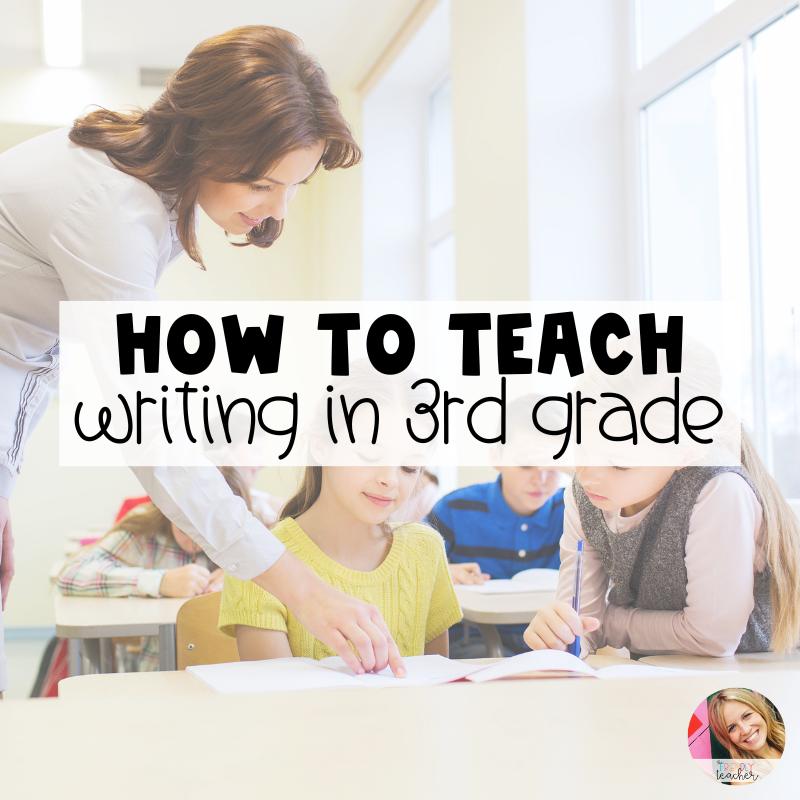
Teaching writing to third graders can be frustrating at times, but it’s also fun! I am going to share three simple tips to show you how to teach writing to third graders effectively!
How to Teach Writing to Third Graders: Three Simple Ideas
If you focus on these three things, I promise you will see growth in writing throughout the year! Teaching third graders to write should focus on creativity, grammar, and forming a strong paragraph. With these tips you can do just that!
Use Mentor Texts
Mentor texts are a great way to start a unit. They give students something to go off of and start their creative process.
How does this work?
- Read the mentor text (any picture book) and talk about the writing style through discussion questions.
- Do one or two activities to go with the mentor text to strengthen their understanding of the text and the writing process.
- Start a writing unit/process that focuses on that text.
Example: Read any of the Who Would Win books (highly recommended for the third grade age range). Then, have students research two animals. Then, they write a research essay on Who Would Win between those two animals. Check that unit out here!
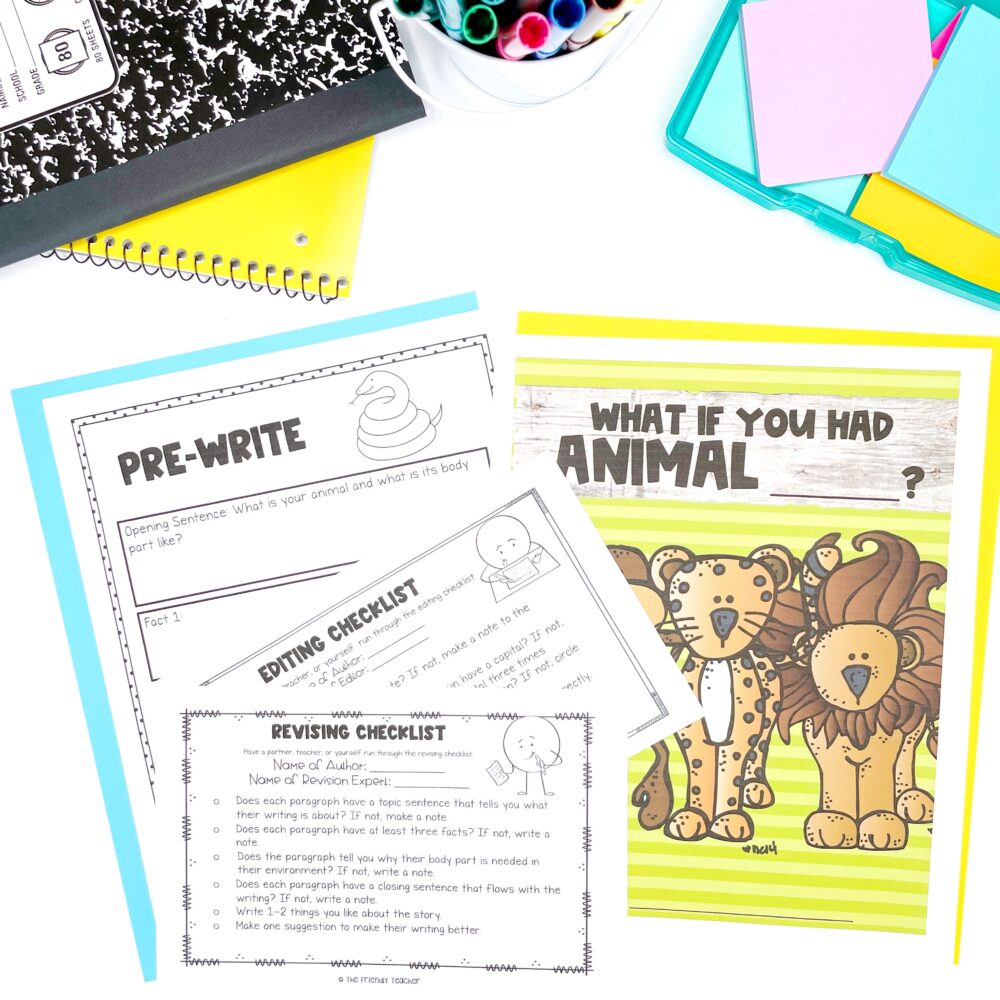
Go Through the Writing Process
When thinking about how to teach third graders to write well, the writing process always comes to mind. Explicitly teaching students how to go from creative idea, to rough drafts, to final draft is important.
But how does this look?
- Introduce the prompt through a mentor text. ( Psst…see above! )
- Allow students to think creatively about ideas for the prompt. (Brainstorming!)
- Then, have students do a prewrite to take their idea to a format that would fit that paper.
- Rough Draft! Explicitly teach students how to rough draft and not worry about errors until later. ALWAYS do this paper and pencil.
- Editing and Revising. I typically edit one day and revise the next day. During this time, I will work with a small group of students and have the rest of the students editing and revising each other. Using a checklist is a great way to make sure they are looking for the right items!
- Final Draft- Discuss the importance of getting the grammar, sentence structure, spelling, etc., correct during this step.
While you are doing all of this, teach mini-writing lessons. Example: After rough drafts, teach a lesson on descriptive language, and have students go back through their rough draft to add descriptive words.
This typically takes 2 weeks to complete for one prompt.
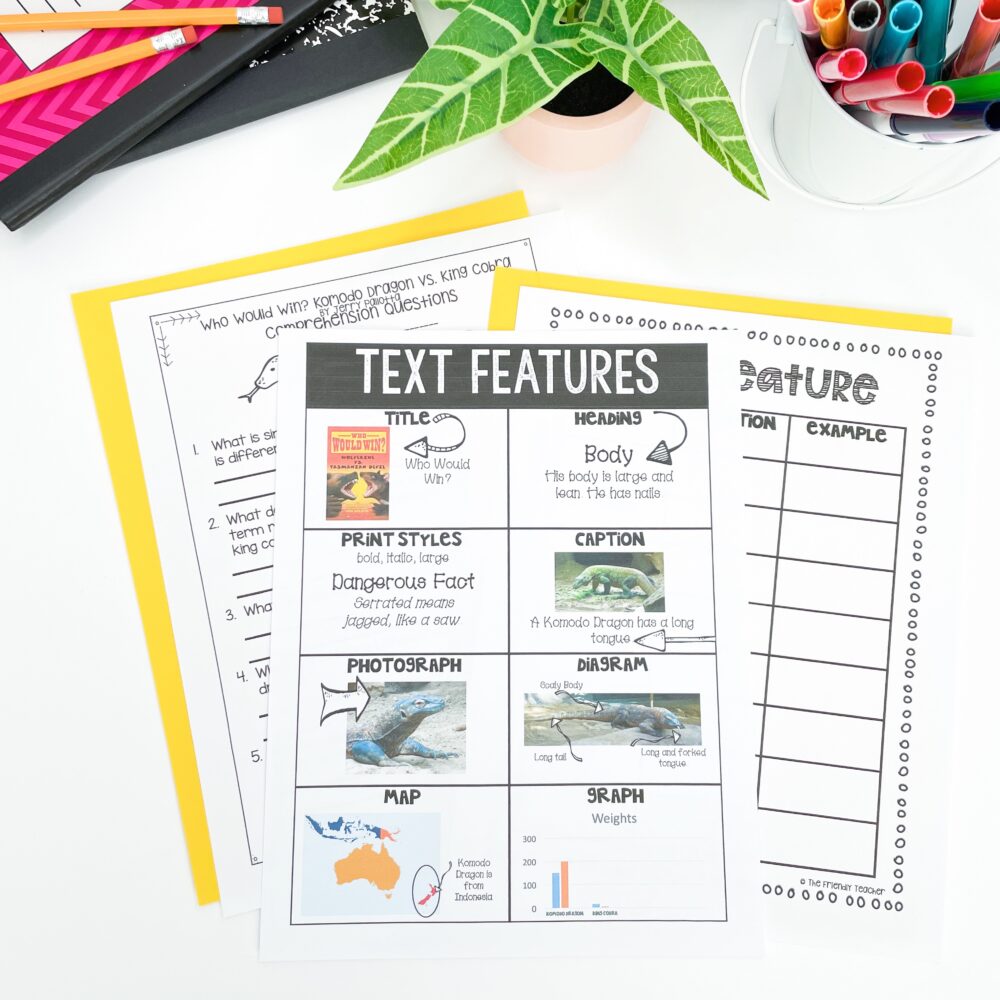
Focus on One to Two Skills Each Writing Unit
Each time you begin a unit, decide on one or two things you want to focus on. Different skills could be: descriptive language, quotations, paragraph formation, citing research, etc.
The goal is to pick one or two to focus on. Trying to focus on all parts of writing each unit will leave you exhausted and your students will learn nothing.
Then, teach a mini lesson on that skill before they begin their rough draft and again after the rough draft. When editing and revising, you can focus on that skill. Then, while grading the writing, assess that skill.
How to Teach Writing to Third Graders: Bonus Tips
- Add a free write day each week. This keeps students who love to write extra engaged in the process.
- Play a game like Left, Right, Center when it comes to editing and revising. You roll a dice and if it says to pass the paper to the left or right, the students do so. Then, they do the first editing part on the checklist for that paper. If it says to throw it in the center. They move all the papers to the center and go to a new seat and grab a new paper to do the next checklist part. This way they are editing multiple writing samples and they are extra engaged!
- Use holidays to add extra engagement to writing! Ex: My Santa Letter Writing unit found here!
- Add videos to teach and review skills. Here is my favorite set of writing videos!
- Want everything ready to go for you?! I have an entire year’s worth of writing units that are full of lesson plans, writing processes, and more! Check it out here!
Want a free sample to see how the writing process works? Head here to grab that freebie!
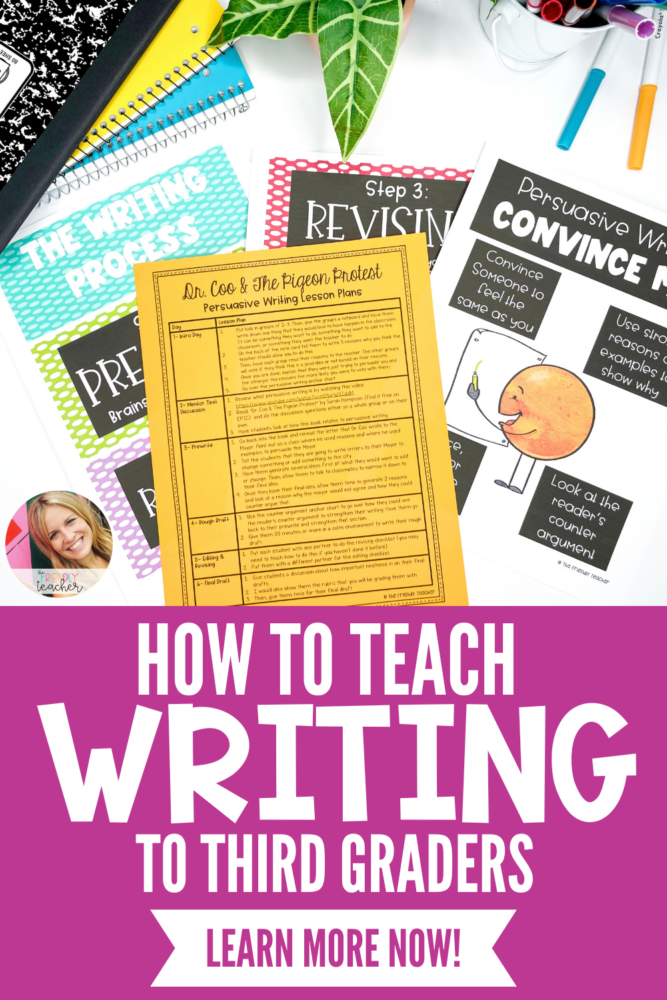
Similar Posts

Earth Day in Upper Elementary!
I love celebrating Earth Day in my upper elementary classroom. This always seems to be a favorite holiday or theme for my students. They are at the age where they are really getting into learning about the earth and how to protect it! This is also the time of the year where we are preparing…
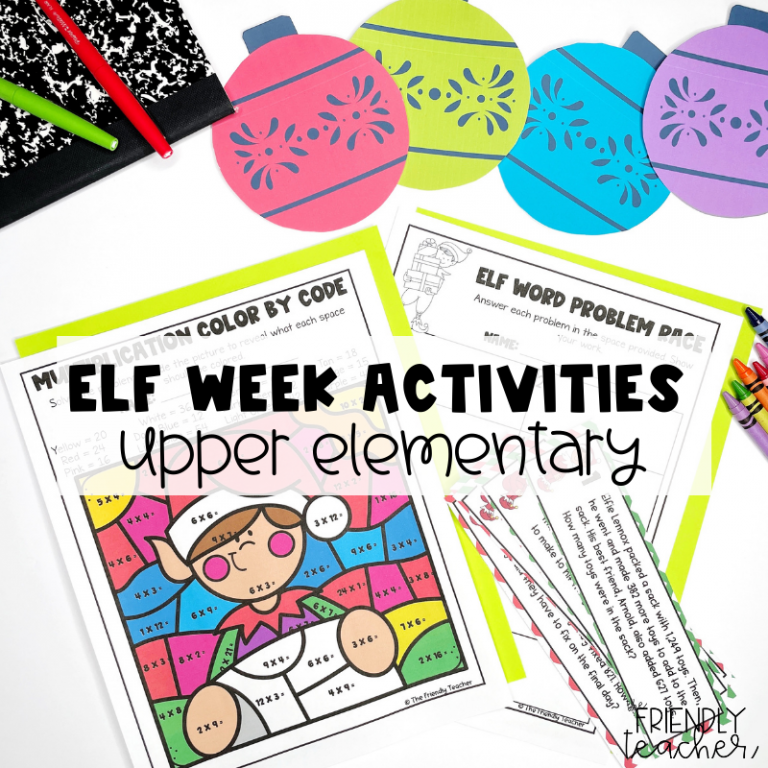
Elf Week in Upper Elementary
Themed weeks in upper elementary are the bread and butter to rigorous learning. When you have a theme for a week or a day your students buy into the learning at a whole other level. During the holiday season, theme weeks are vital to keeping engagement and rigor high! Elf week or day is…
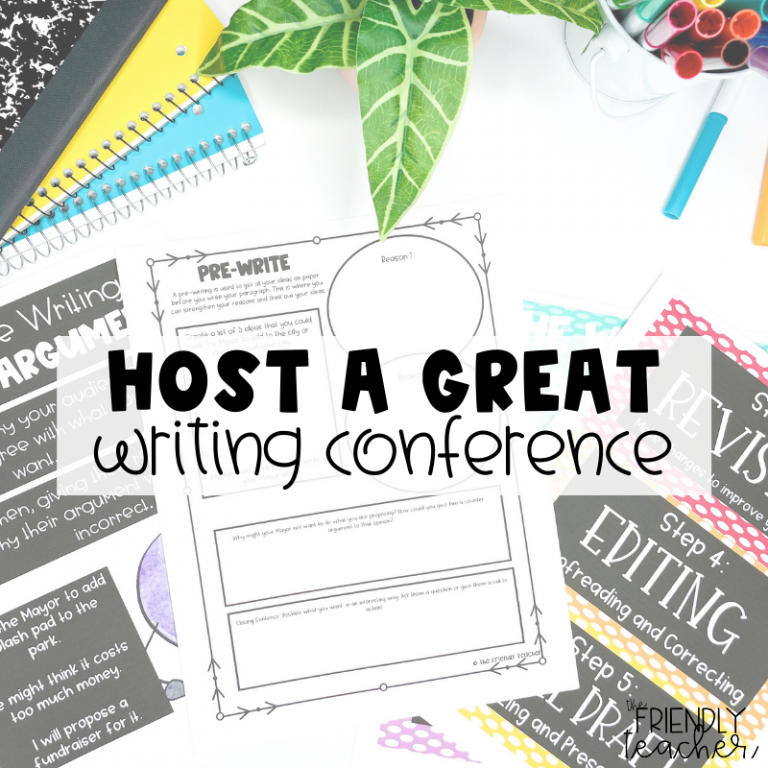
Tips for Successful Writing Conferences
Having writing conferences with students allows them to talk about their writing and make it stronger. Today, I am going to share exactly how to perform and implement writing conferences to improve students’ writing. This post is part of a writing series on teaching writing to upper elementary students. Read about more aspects of teaching…
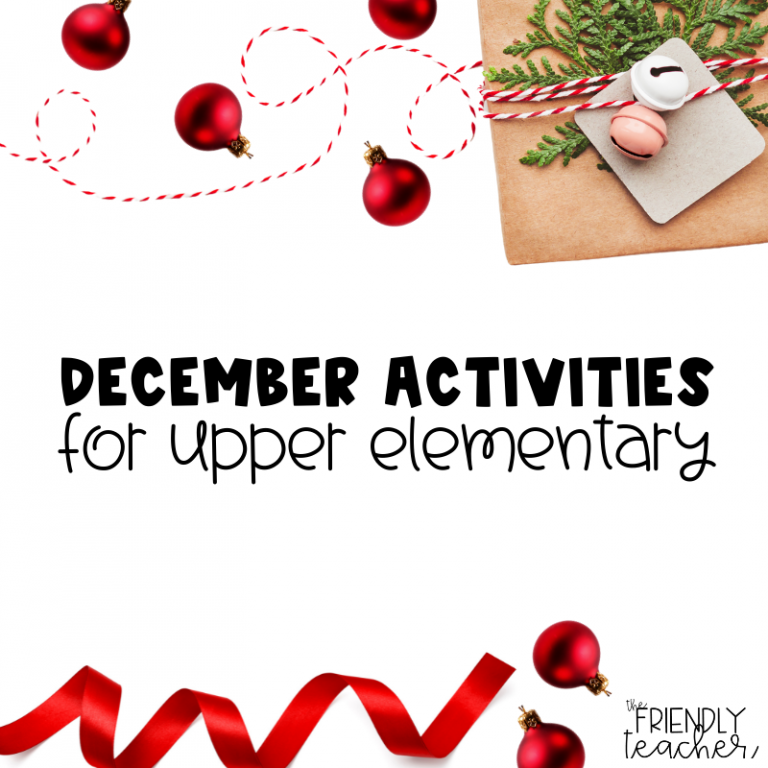
December Reading Activities
Christmas is such a magical time in the upper elementary classroom. You can really challenge your students to think and apply the skills that they have learned in the first half of the school year, all while staying overly engaged. During the month of December, I do not teach a ton of new reading content,…
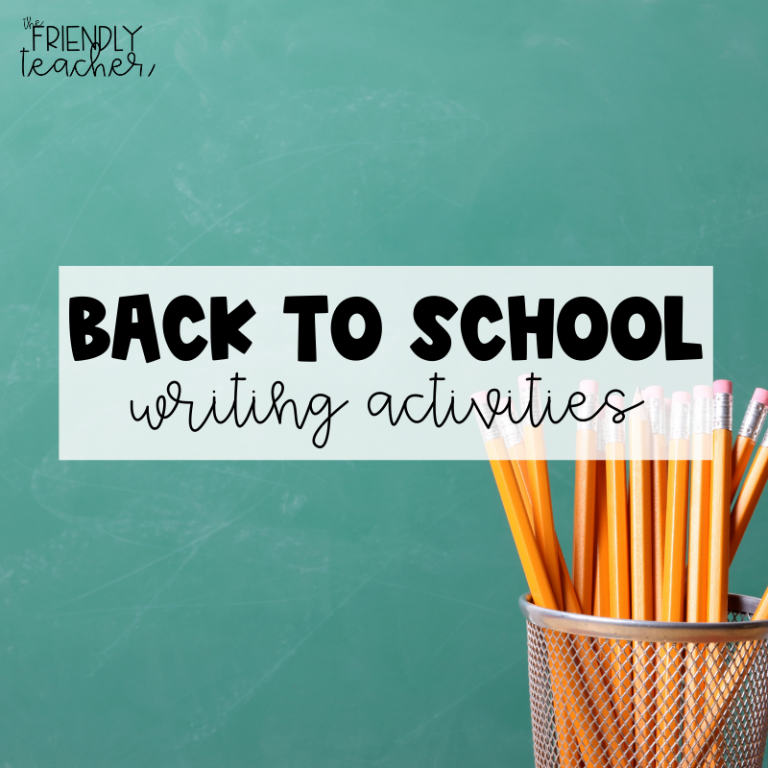
Back to School Writing Prompt Ideas
The back to school season can be full of tons of back to school writing prompts that allow students to get creative, but also allows you to see where their writing abilities are. All back to school writing topics in third grade and above should be combined with a great read-aloud! This allows your writers…

Gift Guides for Teachers, Tweens, Toddlers, Men, Women, & Grandparents 2022
I love a good gift guide, always have! Today, I am sharing gift guides for people that I truly buy for and have in my life. Anything on this list I have either bought for someone or am buying this year. Anything Amazon is an affiliate link (thank you for supporting my family) and anything…

Hannah Wilde
I am so glad you’re here! I love helping 3rd-5th grade teachers by providing ideas, engaging resources, and professional development they need. I am a literacy coach who is here to help lessen the workload for teachers while making them more confident! I want students to be continually engaged in a rigorous environment!
Leave a Reply Cancel reply
Your email address will not be published. Required fields are marked *
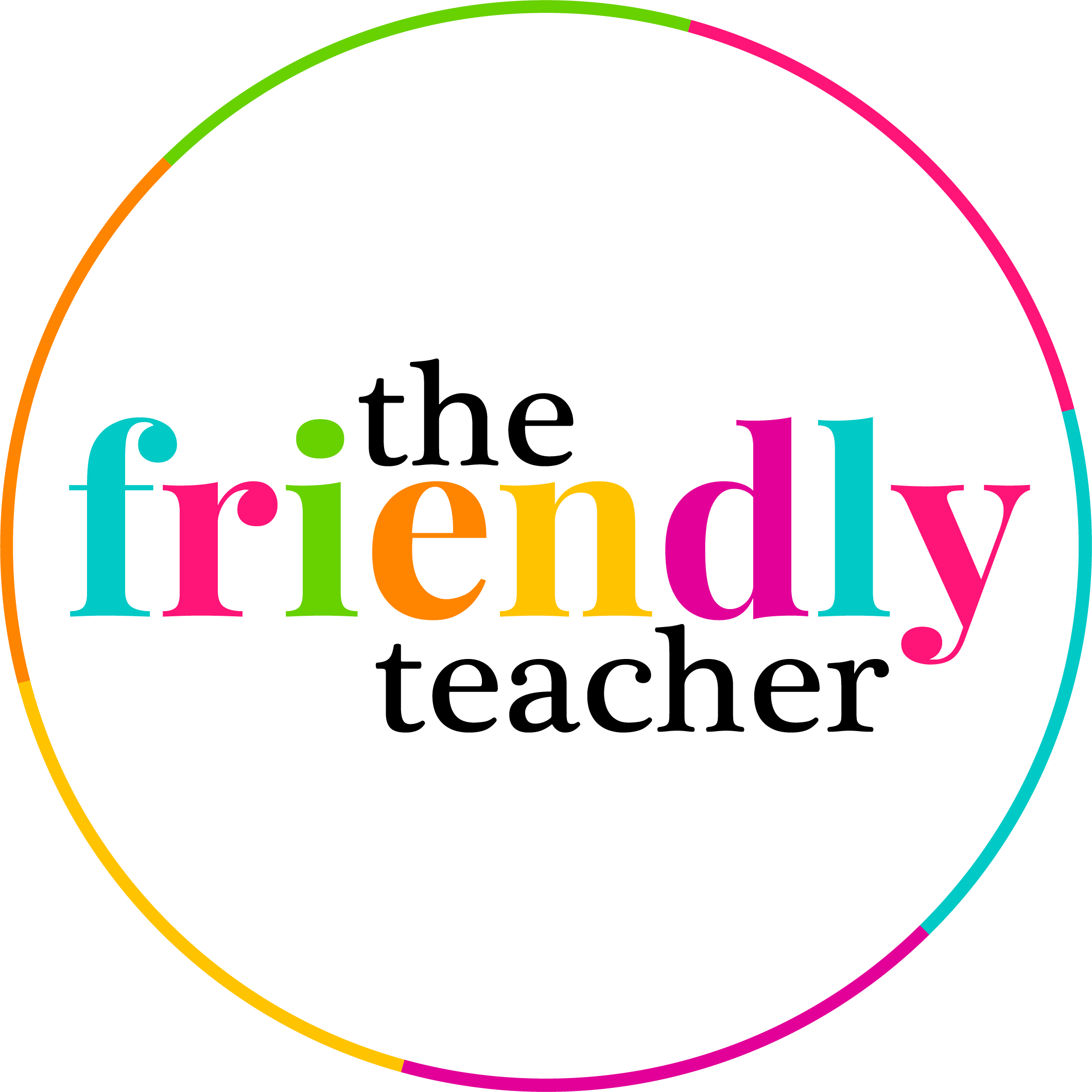
Copyright 2023 The Friendly Teacher. All Rights Reserved. Site Design by Ashley Hughes .
Username or Email Address
Remember Me
Lost your password?
Don't have an account yet? Sign up
Review Cart
No products in the cart.
How to Teach Third Graders How to Write an Essay
Kristie sweet.

According to the California Department of Education, third-grade students should be able to write well-developed essays that clearly illustrate a main idea. Students this age should be familiar with both narration and description and use standard English conventions. Third-graders need to apply the writing process to essay assignments, so teachers should use those steps in instruction: pre-writing, rough draft, revision and editing/proofreading. Assignments should allow students to be creative within these conventions.
Pre-write. Start with a brainstorming activity focused on the assignment. For instance, if the paper needs to be a description, tell students to make a list of places that are meaningful to them along with a few words that illustrate the importance. Give an example. One line of a brainstorming sheet might look like this: "mountains: peaceful, relaxing, quiet."
Develop a thesis statement. The thesis statement is a single sentence that explains what the paper is about. Ask students to summarize their point in one sentence. Again, use an example, such as this: "One of my favorite places is a spot by the river in the mountains because it is peaceful and relaxing."
Write a rough draft. Develop the ideas that support the thesis with specific details. Third-graders should focus on one body paragraph at a time, creating a vivid picture and connecting the ideas clearly to the point: "The sounds of the area make it a good place to relax."
Add an introduction and conclusion. Essays should include introduction and conclusion paragraphs that are separate from the body paragraphs. Explain that the purpose of the introduction is to give the thesis but also get the reader's attention through something like a quote or statistic. The conclusion should summarize the ideas and emphasize the point. Practice introductions and conclusions by putting several thesis statements on the board and having students come up with samples of good beginnings and endings. The peaceful mountains essay might begin with an introduction focusing on the stresses of everyday life, for instance.
Share. Peer evaluations help students become better writers by using feedback from others. Give some guidelines regarding evaluations; students should look for a clear thesis, make certain the details support the main idea and see if the language and mechanics create reading difficulties.
Revise. Use the suggestions from peer review to restructure sentences and add or delete details.
Edit and proofread. Look for grammar, spelling and punctuation errors. Remind students of grammar issues you have studied and how to find them in their writing. Reading aloud is a good strategy, and students who finish papers on a computer should run a spell check.
About the Author
Kristie Sweet has been writing professionally since 1982, most recently publishing for various websites on topics like health and wellness, and education. She holds a Master of Arts in English from the University of Northern Colorado.
Related Articles

How to Write an Introduction for a Character Analysis

How to Write a Good High School English Essay

Synonym & Antonym Activities for 3rd Grade

How to Write an Eagle Scout Speech

How to Transition to the Body of an Essay

Tools to Help You Organize Thoughts & Write a Research...

What Is the Difference Between AP English Literature...

Lesson Plan Ideas for Teaching Point of View for Middle...

How to Write an Analytical Paragraph

How to Restate an Expository Writing Prompt

How to Make Paper Hold a Brick

How to Write a Request for a Waiver for the Military

How to Revise an Essay

How to Write an Essay on Encouraging Students to Volunteer

How to Write a Conclusion for a Compare & Contrast...

How to Choose a Title for Your Research Paper

How to Add More Curl to My Wavy Hair

Polish Crafts for Children

Classroom Activities for Hairy Maclary

What Is a Dictation Sentence?
Regardless of how old we are, we never stop learning. Classroom is the educational resource for people of all ages. Whether you’re studying times tables or applying to college, Classroom has the answers.
- Accessibility
- Terms of Use
- Privacy Policy
- Copyright Policy
- Manage Preferences
© 2020 Leaf Group Ltd. / Leaf Group Media, All Rights Reserved. Based on the Word Net lexical database for the English Language. See disclaimer .
Sign up to get access to exclusive teaching resources, activities and, ideas!

How to teach Opinion Writing to 3rd, 4th and 5th Graders
Opinion writing, also known as Persuasive writing, is by far an easy enough genre to teach 3 rd , 4 th, and 5th graders. Unlike narrative writing where creativity and flair come into play, the elements of opinion writing are more structured, almost formulaic, and thus easier to assimilate.

Teaching The Structural Components of Opinion Writing
Students are known to turn out better writing pieces if they have direction. Hence explicitly teaching the structural components of a persuasive/opinion essay is essential.
If students are taught the form and structure of opinion writing, the job is half done. The success of the other half pretty much depends upon the writer’s content knowledge of the subject.
Teaching the structure of an opinion essay can thus be broken down into three major sections: The Introduction, The Body, and The Conclusion.

✏ The Introduction of Opinion Writing
How many times have we reminded our students that the beginning of an essay is so very important – that it has to arrest the reader’s attention so they are hooked to continue reading.
For the introduction to be effective, it must have a hook , the writer’s opinion, and a thesis statement . This is the structure of the introduction.
If students just practice writing an introduction on several given writing prompts for a week, adhering to structure for this section, will be second nature.
The Hook In the Introduction
Teaching students just one way to hook the reader in an opinion essay is not enough as different types of hooks would create different effects – besides we need to give our little writers lots of choices when it comes to writing. This flexibility goes a long way in getting their creative juices going when writing supporting details that support their opinion.
5 Popular Hooks to Support the Opinion
So you can teach your 3 rd , 4 th, and 5 th graders to begin their opinion essay with any one of the five different hooks. Interestingly, they are also called sizzling starts. And rightly so.
Students may begin with any one of the below hooks:
- Strong Statement
- Rhetorical Question
The first two starters are popular starters and I often encourage my 5 th graders to use either of them in their introduction.

Writing the Opinion of an Opinion Essay
Right after the hook, students write their opinion on the issue after weighing the pros and cons.
Now for the lower grades (grades 1-3), students could simply begin their opinion with any of the phrases:
- ‘In my opinion..’
- ‘I firmly believe…’
- ‘I am of the opinion…’
However, 3 rd , 4 th, and 5 th graders need to show more sophistication in their writing, so beginning with these opinion starters would not do justice to the writing skill they are actually capable of implementing.
Instead, students need to convey their opinion subtly by reflecting on the issue. This will consequently lead to the thesis statement that follows next and sums up the introduction.

✏ Writing The Body of an Opinion Essay
We can teach our 3 rd , 4 th, and 5 th graders to adhere to structure when they write the body paragraphs of their opinion essay too.
Each body paragraph needs to have a reason introduced by a topic sentence , supporting details that support the reason, and a concluding sentence that sums up that body paragraph. If students are explicitly taught this structure, then they are more likely to stay on task and won’t get carried away in their writing.
So, how many body paragraphs should there be?
The best number, I tell my 5th-grade students is – three. Each reason is given its very own paragraph, with the last paragraph reserved for the most important reason.
The least strong reason should be sandwiched between the first strong reason and the last. This is in keeping with the notion that the beginning and end of any piece of writing are the most important.

✏ Writing The Conclusion of an Opinion Essay
Some students are known to get so carried away with their reasoning in the body paragraphs that they often skip this last important section or don’t have the time to write it – if sitting a timed writing examination.
It is in this section, that students need to be reminded to re-visit their opinion, provide a summary statement of their reasons, and the most important of all – give a call to action that causes the reader to reflect on the issue. In a real-life context, this call of action would induce the reader to take action on the basis of the arguments put forth.

The Effective Approach to Teaching Opinion Writing
Now that all the structural elements of an opinion essay have been dissected, how does one go about teaching them explicitly to students – that is the question.
Based on my personal experience and in my opinion, the best approach would be to teach each structural component separately . This would entail providing ample practice and modeling on the elements involved.
Once students have a good understanding and practice of the structural components of each section, then they can write out the entire opinion essay, given a prompt. Prior to doing so, brainstorming ideas for each section on a graphic organizer would help structure students’ writing further and provide direction.
My Summary of How to Teach Opinion Writing to 3 rd , 4 th and 5 th Graders
So just a few take-away points for you when you next teach your 3 rd , 4 th, or 5 th graders how to write an opinion essay.
1. Teach students each structural component separately prior to having students write out the entire opinion essay based on a prompt.
2. Teach students how to write the introduction first in an opinion essay. This should include the different types of hooks, the opinion, and the thesis statement.
3. Teach students how to write the body of an opinion essay. This should also include each reason introduced by a topic sentence, 2-3 supporting details to support the reason, and a concluding sentence to conclude the paragraph and link back to the first reason in the topic sentence. This explicit teaching should be done for all body paragraphs.
4. Teach students how to write the conclusion which restates the writer’s opinion, provides a brief overview of the reasons, and gives a call to action.
5. And above all, remind students to edit their draft prior to publishing.
All this explicit teaching needs to be adequately supported by teacher modeling and ample student practice for each structural component of the opinion essay.
To conclude this post, structure provides focus and clarity of thought. Both of which we desire our students to have in order for them to turn out writing pieces that they are proud of and that we enjoy reading and – yes marking.

Need a collection of self-written mentor texts ( no need to spend on books ), print-n-go sheets, interactive notebook activities, Scavenger Hunts, flipbooks, anchor charts, posters, checklists, and marking rubrics to teach your students a step-by-step approach to writing an opinion essay effectively? Then access the Opinion (Persuasive) Writing Growing Bundle.
Teaching Opinion Writing digitally? Learn more here.
And if you’d like a set of free Opinion Writing Signal Words posters to display in your classroom, access the link in the image below.

Until Next Time…

5 thoughts on “How to teach Opinion Writing to 3rd, 4th and 5th Graders”
That’s great to know Luna – Thank you 🙂
Wow this is awesome!
Glad you liked this post! Thank you 🙂
Leave a Comment Cancel Reply
Your email address will not be published. Required fields are marked *
Save my name, email, and website in this browser for the next time I comment.

Growth Mindset Quotes Classroom Decoration

Simple Compound and Complex Sentences Examples

Free Fathers Day Activities For Students

Tightening Tension In A Gripping Narrative

Sizzling Starts Narrative Examples Strong Leads

20 Proven Reading Comprehension Strategies With Actionable Reading Responses
- Terms of Use
COPYRIGHT © 2024 TEACH2TELL • ALL RIGHTS RESERVED • SITE DESIGN BY LAURANE RAE
We noticed you're visiting from Australia. We've updated our prices to Australian dollar for your shopping convenience. Use United States (US) dollar instead. Dismiss
Terrific Teaching Tactics
Make Learning Fun
Third Grade Opinion Writing Unit
Are you struggling to teach writing to your 3rd graders? Perhaps you just don’t know where to start. You’re constantly googling, ‘how do you teach writing to 3rd graders?’ or ‘how can I help my 3rd graders with writing?’ You’re tearing your hair out with frustration.
Maybe it’s because your school doesn’t provide you with a writing curriculum. So, you’re spending your precious evenings and weekends looking on Pinterest for lesson ideas. Or worse, a curriculum is provided…but it’s just downright terrible. You can’t make sense of it and your students hate it.
Perhaps your students just hate writing in general and roll their eyes at the thought of it.
Well, here’s the thing. Teaching writing ‘aint easy. In fact, it can be straight up tricky, I get it!
But don’t worry friend, I’ve got you covered.

INTRODUCING TERRIFIC WRITING
Terrific Writing is a comprehensive writing curriculum for Third Grade. This curriculum is standards based (to the common core) and genre based. But best of all, it’s actually easy to teach and engaging for students!
In this curriculum, your students will develop a love of writing. The graphic organizers, interactive notebooks, and final craft will engage students much more than a blank piece of paper. The final writing piece asks students to write about something they love that they have chosen! After all, students love to write about things that they are interested in.
Writing doesn’t have to be dull and students definitely shouldn’t hate writing!
In Unit 2 ‘Opinion Writing’, students learn how to write engaging opinion writing pieces.
ARE YOU SHORT ON TIME?
This 5 week unit has EVERYTHING you need, because let’s be honest, teachers are time poor.
So, let’s get your evenings and weekends back, my friend! Take a break from lesson planning and searching for engaging materials. It’s all right here.
Are you ready? I’m going to share some of the awesome things about it!
WHAT’S INCLUDED IN THIS THIRD GRADE WRITING – Opinion Writing UNIT?
First up, there are a bunch of teacher docs. Unit contents, common core standards, and teacher directions? Check.
To begin, there’s some suggested mentor texts (with links to Amazon and YouTube). Also, a scope is included which shows the 25 lessons that feature in this unit and the third grade common core standards that are relevant.

Also, there is a unit at-a-glance calendar, as well as a table which tells you what materials you will need for each lesson. Basically, I’ve tried to make this unit super easy to implement. It has everything you need!

Next, there’s some suggested lesson times. To clarify, it doesn’t matter how long your writing block is, this unit can be adapted to suit it!
A lot of teachers struggle with finding the time to teach writing. If this is you, you’re not alone!

Then, there’s the 25 scripted (and step-by-step) lesson plans. The lessons follow a simple format of mini lesson, think and share, and independent writing time. There’s a lesson focus to guide you and all of the required materials are listed with numbers. For example, you’ll know exactly which posters and printables you need.

Subsequently, there’s a video that comes with this unit. This will help you organize and implement everything.
Wondering how to assess your student’s writing? Don’t sweat it!
There’s an assessment document for this unit too. It includes a rubric to help you grade your student’s writing.
However, I’m not just throwing you to the sharks here! Rubrics can sometimes be generic or difficult to decipher. That’s why I’ve made a comprehensive document with teacher directions, as well as elaborations and examples. Moreover, there’s a video to help you understand the rubric.

OPinion Writing MENTOR TEXTS
I do give a list of suggested mentor texts that you can source, but in addition, I provide three original mentor texts for this unit! These come in PDF and PowerPoint versions (as well as color and black and white). You can print them in any size or just display them on an interactive whiteboard.
The great thing about these original mentor texts is that they include all of the features of opinion writing that are taught in the unit. For example, students will see examples of opinions, reasons, and a closing.

Opinion Writing POSTERS
This unit comes with 19 posters that you can reference to! Each lesson corresponds to them. Most importantly, they are great for giving writing ideas and reinforcing the opinion writing structure.

You can print them in color and laminate them. They are great for displaying in the classroom. However, you can also display these posters digitally (if you have limited printing options).

Already interested in this third grade writing opinion writing unit? Grab it here !
OPinion Writing PRINTABLES
There are student workbook covers that you can print. There are three options, ‘My Writing Folder’, ‘My Writing Notebook’, and ‘My Writing Journal’. Your students can glue these covers onto their folders or books. The covers come in color and black and white (there are also boy and girl versions).

Let’s now take a look at the writing prompts, worksheets, interactive notebooks and graphic organizers!
Hands On Printables
There are two interactive notebooks, as well as other cut and paste sorting activities. This way, learning is hands on and engaging!

Graphic Organizers
There are a variety of graphic organizers to help students plan their opinion writing and organize their thoughts. For example, students complete this OREO graphic organizer.

Prompts and Worksheets
There are many different writing prompts and worksheets to help students learn to write opinions and reasons. They write a book review and complete a prompt about their favorite movie. They also answer opinion prompt questions like ‘which is better?’ and ‘would you rather?’
This is the common core standard for opinion writing that is covered with these printables –
CCSS.ELA-LITERACY.W.3.1 Write opinion pieces on topics or texts, supporting a point of view with reasons.

The Final Writing Piece
After students have learnt about opinions and reasons, they begin to prepare for their final writing piece.
First, they plan their writing. Next lesson, they write an introduction. After that, they learn about linking words and paragraphing. Then, they add details and examples to their reasoning. Finally, they write a closing.
These are the common core standards for opinion writing that are covered with these printables –
CCSS.ELA-LITERACY.W.3.1.A Introduce the topic or text they are writing about, state an opinion, and create an organizational structure that lists reasons.
CCSS.ELA-LITERACY.W.3.1.B Provide reasons that support the opinion.
CCSS.ELA-LITERACY.W.3.1.C Use linking words and phrases (e.g., because , therefore , since , forexample ) to connect opinion and reasons.
CCSS.ELA-LITERACY.W.3.1.D Provide a concluding statement or section.

Writing Checklists
After students have written their first draft, they use two checklists to proofread their work. One checklist grades opinion writing structure and the other is a more generic checklist for grammar, spelling, and punctuation.
The students do a self check, peer check, and adult check.

Writing Craft
The students create a writing craft for their final writing piece. It’s a flipbook, so they can add as many pages underneath as they need! This craft is great for a bulletin baord display.
They write about their favorite thing (that they own). This gives students the choice to write about anything they like (which keeps them far more engaged)!

I think it’s super imortant to have purposeful early finisher tasks and extension activities during writing lessons. Above all, we should be challenging our advanced writers. That’s why this unit also includes task cards for opinion writing.

Third Grade Writing – Opinion Writing
Here’s an overview, with some more information about the unit –
- 25 step-by-step scripted lesson plans
- 18 graphic organizers / worksheets
- 2 interactive notebooks and 1 writing craft
- 3 original mentor texts (PowerPoint versions and PDF in color and b&w)
- 24 tasks cards extension activities (2 versions – b&w, color)
- 1 assessment rubric

Here’s everything else that’s included in this unit –
- Video overview to help organize and implement the unit
- List of common core standards that align with this unit
- Teacher directions for the lesson plans
- Suggestions for differentiation and lesson times
- List of recommended mentor texts (with links)
- Unit scope and at-a-glance calendar
- Lesson materials list
- Student book/folder cover (3 versions – journal, notebook, or folder)
- 1 writing prompt pre-assessment
- 3 lined pages (for first drafts and crafts)
- 2 checklists
- 1 set of compliment notes (2 versions – b&w, color)
- 1 certificate (2 versions – b&w, color)
- Teacher directions, examples, and elaborations for the rubric
- Video with tips for using the rubric
Click here to see a video that shows everything in the unit.
I hope you’ve enjoyed reading about this third grade writing – opinion writing unit.
Click here to grab the full unit!

Sharing is caring!
Reader Interactions
August 24, 2023 at 1:03 pm
I’m a English teacher in Mexico, I’m interested in worksheets for writing. Your material looks very interesting.
August 25, 2023 at 5:13 am
I’m so glad to hear! Be sure to check them out and let me know if you have any questions 🙂
Leave a Reply Cancel reply
Your email address will not be published. Required fields are marked *
Save my name, email, and website in this browser for the next time I comment.
Teacher Instagram

TPT Seller Instagram
Save 10% on your first purchase! Use the coupon code TERRIFIC10 at checkout. Dismiss
We noticed you're visiting from Australia. We've updated our prices to Australian dollar for your shopping convenience. Use United States (US) dollar instead. Dismiss
- Skip to main content
- Writing Masterclass
- Math Masterclass
- Course Login
- YouTube Channel
- Facebook Group
- Search this website
Not So Wimpy Teacher
The Not So WImpy Teacher creates resources for busy teachers in grades 2-5 who are looking to deliver engaging and meaningful lessons without overwhelm and chaos.

Get my FREE Editing & Revising Centers
Get my free editing & revising centers.
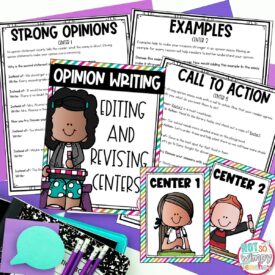
Help your students master tricky writing skills with these FREE Editing and Revising Centers. Students in grades 2-5 will love this fun, collaborative way to practice editing and revising. Perfect for test prep and review.
We won't send you spam. Unsubscribe at any time.

Last updated on July 29, 2023 by Not So Wimpy Teacher
Teaching Opinion Writing: 8 Must-Do Tips
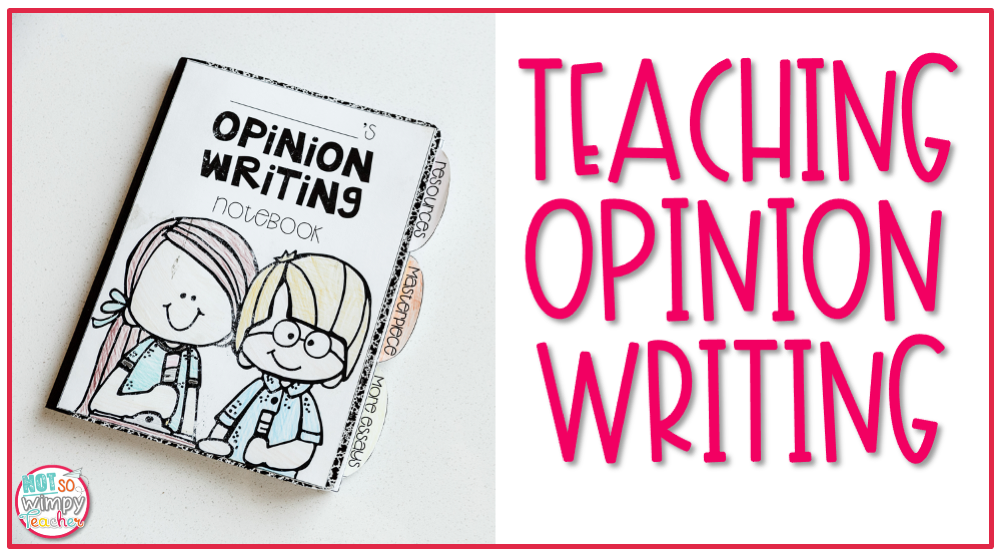
I love teaching opinion writing. And students love it too. Opinion writing is the third writing genre I teach. I recommend teaching writing in units, starting with personal narrative, informational report, opinion writing, and finally, fiction.
This approach allows you to spend eight full weeks practicing one specific type of writing so students can truly master the skills. Today I am sharing 8 Must-Do Tips for teaching opinion writing. For more information about what to teach in each genre, check out my handy writing guide: What to Teach in Writing .
Check out this video about teaching opinion writing:
Keep reading to see our best tips for teaching opinion writing.
1. Start with a pre-assessment
The first must-do tip for teaching opinion writing is to start with a pre-assessment. The pre-assessment allows you to see how much students know so you can tailor your lessons appropriately and it allows you to measure student growth at the end of the unit.
Give students a simple writing prompt and one writing period to respond to it the best they can. Try not to answer too many questions during this writing time. You want to see what students know.
Use a simple rubric to score the sample (but don’t add the grade to the grade book). Then you can use the sample to plan your lessons, formulate conference groups, and use as a baseline. It’s not realistic to expect all your students to master all the opinion writing skills after eight weeks. But when you compare their pre-assessments to their final masterpiece, you will be able to see how much they have grown as writers.
2. Provide examples
At the beginning of your opinion writing unit, you need to spend a day or two teaching WHAT opinion writing is. You can’t expect students to write strong opinions if they don’t know what opinion writing looks like.
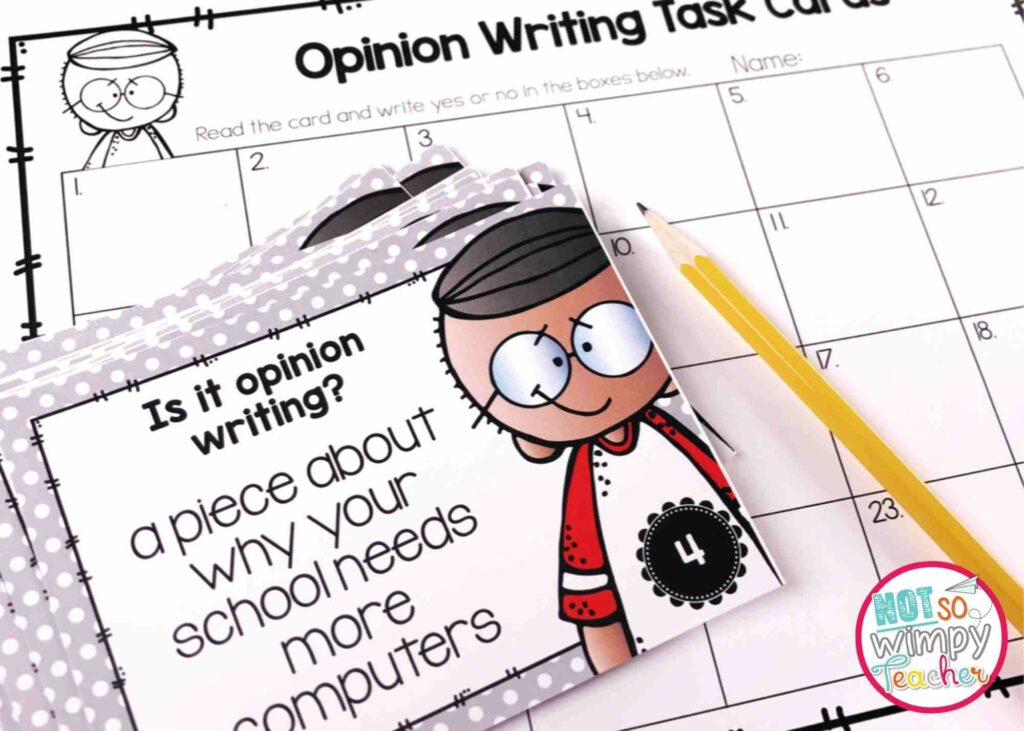
Use lots of mentor text passages (I include them in my writing units) and books. Once you’ve gone over several examples of what opinion writing is, a task card scoot is a great way to check for understanding.
3. Give choice
Allow students to choose their own writing topic. This is the best way to increase their excitement and ownership. No-one wants to be told what to write about. Imagine if someone told you that you had to write an opinion piece on why NASCAR is the best sport and you didn’t know anything about NASCAR. That wouldn’t be a very fun assignment.
Students feel the same way. They are much more invested in a writing project when they can choose what to write about.
But that doesn’t mean choosing a topic will come naturally. Plan to spend 2-3 days of your opinion writing unit teaching strategies for generating topics. Two of my favorite strategies are challenging students to come up with lists of their favorites (things like hobbies, goods, movies, etc.) and things that they want (a kitten, to go camping, to eat ice cream every day).
They can pick a favorite item from one of those lists and turn it into the topic for their opinion essay. They will use their essay to try to convince you that they are right. (Toy Story is the best movie, Why I Should be allowed to eat ice cream every day).

4. Draft early
This might be the most important tip for teaching opinion writing or any type of writing. Let students draft early in the process.
If you try to teach every skill prior to letting students write, they will get bored. Plus, it is impossible to teach them everything they need to know before they start writing.
Instead, let them draft right away. Then each day you can teach a mini lesson on important skills. After you have taught the mini lesson, have students go back to the draft and revise using the new strategies you have just taught.
The key is to keep this process simple. Break mini lessons down into bite-size pieces. Have students practice just one or two strategies a day. And don’t expect perfection.
5. Plan bite-sized lessons
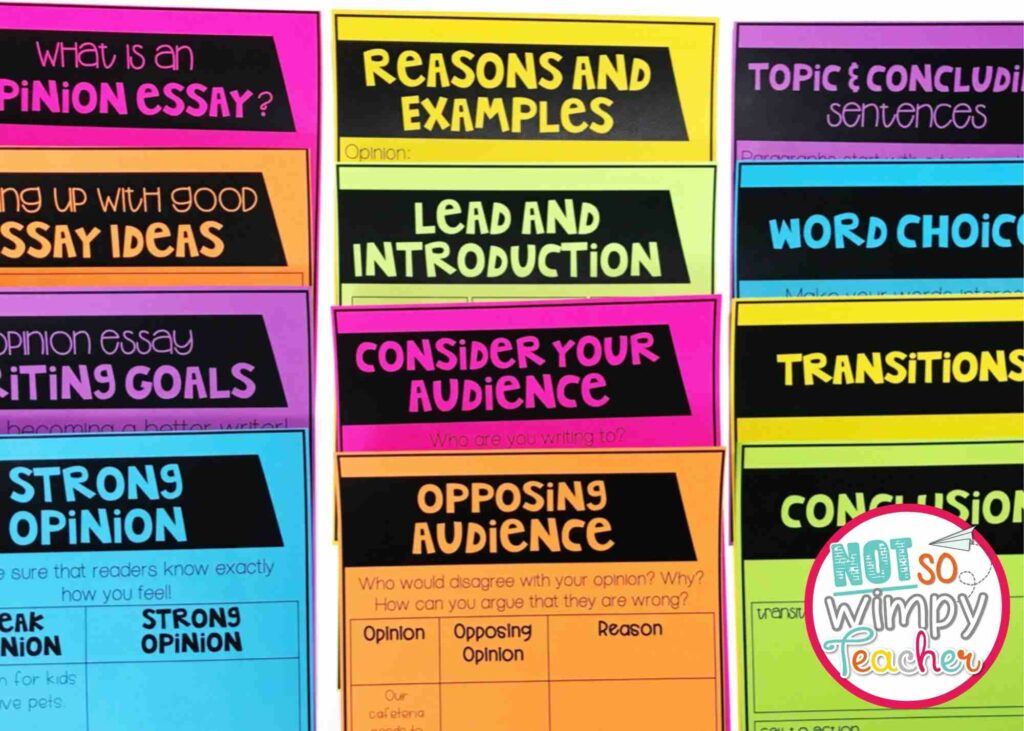
When teaching opinion writing, you will need to teach students to use both reasons and examples to support their opinions. But it is super important to separate these into different lessons.
You will want to teach a lesson or two on using reasons to support opinions. And then another lesson on using examples. When taught together, most students don’t understand the difference between reasons and examples.
Plan to spend more time focused on reasons because they are essential to good opinion writing. Some kids may never understand examples in your grade level, but they can still have a quality piece of writing if they include reasons.
6. Look for the opposing opinion
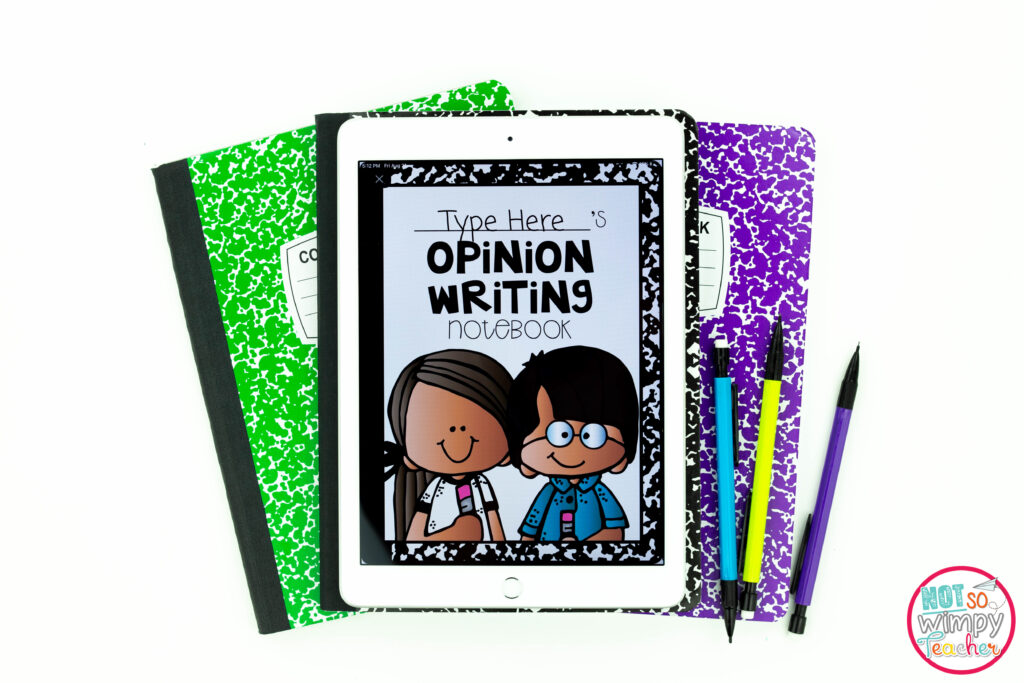
Another important strategy when teaching opinion writing is to help students identify the opposing opinion. When they anticipate objections, they can strengthen their own reasons.
A great way to do this is by asking questions.
- Who won’t agree with you?
- What will they say?
- How can you change that opinion?
When students anticipate opposing arguments, they become better at supporting their own opinion.
7. Make time to edit
I believe that writing is process. First, students draft. Then, they revise. And finally, they edit. When teaching opinion writing, let students spend a day editing their essay. Give them resources like word lists, anchor carts, or editing checklists to help. Also, don’t overwhelm them by having them try to correct every mistake. Instead, have them search for specific errors, like commonly misspelled words or missing punctuation, one at a time.
Then, spend another day having a peer edit their writing. Fresh eyes can often pick up a lot more errors. And the peer can also flag if something doesn’t make sense.
Here’s a bonus tip: reading their own essay out loud helps students to discover more of their errors.
After students have done their editing, resist the urge to correct all of the remaining errors. They are kids and their writing is not supposed to be perfect! Seeing a page marked up with pen is discouraging to everyone.
FREE Editing and Revising Centers
Want to make editing even easier? Check out my FREE Editing and Revising Centers !
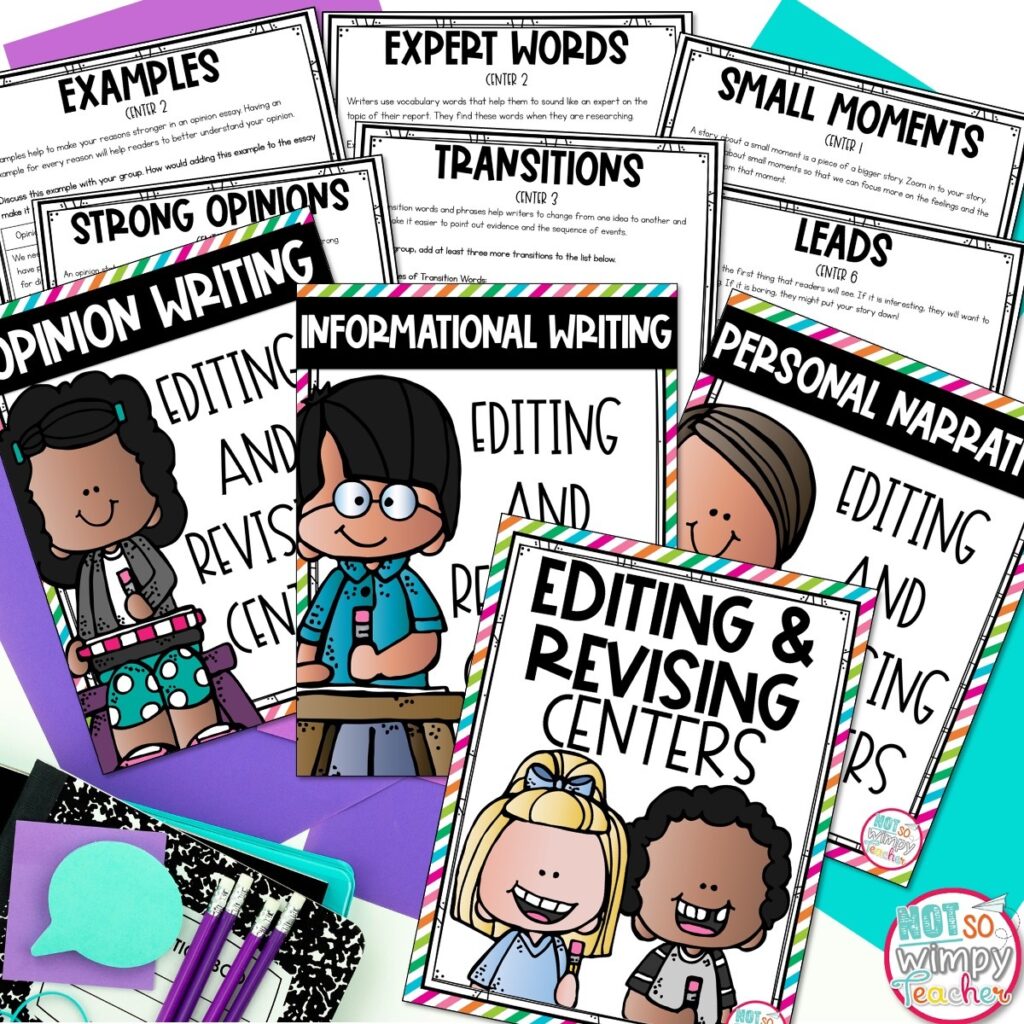
This FREE resource includes centers to help your students master tricky editing and revising skills.
Inside you’ll find:
- 18 hands-on centers, each focused on one specific skill
- Differentiated activities for grades 2-5
- Narrative, opinion, and informational writing tips, examples, and practice activities
- Editing and revising checklists
- Detailed teacher directions and center signs
These centers make a great review activity! Divide your class into groups and let them work together to read the tips, review the examples, practice the skill, and discuss their ideas.
I know you and your students are going to love them!
8. Celebrate student writing
Finally, when you are wrapping up your unit on opinion writing, set aside some time to celebrate.
Find a fun way to publish. Maybe create a class book, “In our humble opinions . . .” or try posting opinion pieces on a class blog. Create an Opinion Page bulletin board and hang up student work.
Try a writing celebration. Have a publishing party and allow students to share with one another. Put them in small groups and let everyone read their writing. Or ask students to share their favorite paragraph. Or try an Opinion Opening Night.
When you make it fun, students look forward to completing their next writing piece.
Opinion Writing Units

My opinion writing units have EVERYTHING you need to make teaching opinion writing easy.
These units are available for grades 2-5 and come with 8 weeks of opinion writing lessons. They include:
- Lesson plans
- Mini lessons
- Anchor charts
- Mentor texts ( you don’t have to purchase any additional books or spend hours hunting in the library!
- Writing tasks
- Conference forms
- Rubrics and more
The lesson plans are simple. All you have to do is print and teach .
Students will learn all of the skills necessary for writing persuasive essays with a strong opinion: how to use facts and reasons, how to write topic and concluding sentences, how to structure paragraphs…and so much more!
Finally, these units make writing fun for your students. You may even find that your students beg for more writing time. And when students enjoy writing and get lots of practice, they perform better on standardized tests.
But you don’t have to take my word for it. Look what Kimberly M. had to say:
This is THE BEST way to teach opinion writing! I love that the mentor texts are provided and that they are fun, interesting, and relatable to my students. It is so fun to read the mentor text to my students and ask them what they think the authors’ opinion is, what their thesis statement is, what their reasons and examples are, etc. I love that this unit focuses on each portion of the essay a little bit at a time. I love to teach reasons and examples with color codes, that way students know that their reasons support their opinion and the examples support their reasons! There are so many wonderful tools for teaching and learning in this resource, especially the anchor charts! I like to use them as a guide to create larger anchor charts with my students, but they cover all of the information that I need in the unit! – Kimberly M.
Shop This Post
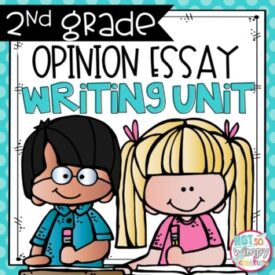
Second Grade Opinion Writing Unit
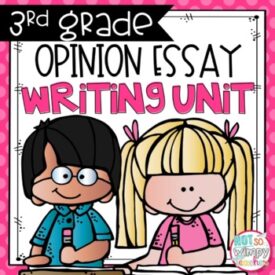
Third Grade Opinion Writing Unit
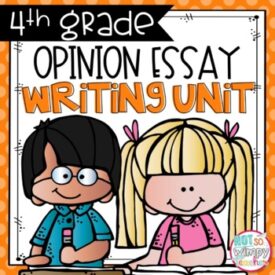
Fourth Grade Opinion Writing Unit
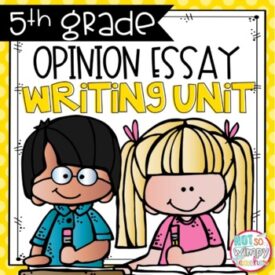
Fifth Grade Opinion Writing Unit
More tips for teaching writing.
Want even more tips on how to teach writing? Then you will love my online professional development course, the Not So Wimpy Writing Masterclass . I specifically developed this online professional development course for teachers in grades 2-5 to help simplify writing workshop and provide the tools and strategies you need to be a more confident writing teacher.
You’ll learn tried and true strategies for how to teach writing , including how to:
- Teach writing in units
- Create manageable mini lessons
- Keep students on task during independent writing time
- Implement a successful writing workshop without chaos and confusion
- Transform ALL your students into eager and excited writers who have the skills needed to perform well on standardized tests
In short, this course is designed to help you become a more confident writing teacher , regardless of what writing curriculum you have (or don’t have).
And the Masterclass is so easy to take. It’s entirely online ! You can watch whenever and wherever works best for you. And you get lifetime access to the course, which means you can return to the videos over and over again.
Check out the amazing bonuses!
Not only do you get 38 training videos , a 10-hour professional development certificate , a course workbook, and tons of tried and true strategies that have been used successfully in thousands of classrooms, but you also get these incredible bonuses:
- Compare and Contrast Reading Response Essay Writing Unit – Give your students extra practice with this tricky skill with my easy-to-use lessons.
- Bonus Module: Video Trainings of 3 Genres – See the must-know tips and tricks for teaching the most important skills in personal narrative, informational report, and opinion essay writing.
Ongoing Support – You’ll get immediate access to the exclusive Not So Wimpy Writing Gurus Facebook group where you can ask questions, get ideas and inspiration and interact with the Not So Wimpy team and Masterclass alums (aka other teachers).
Registration for the Not So Wimpy Writing Masterclass is currently closed. Be sure to sign up for the Waitlist so you will be the first to know when we open it again. Sign up now so you don’t miss out!
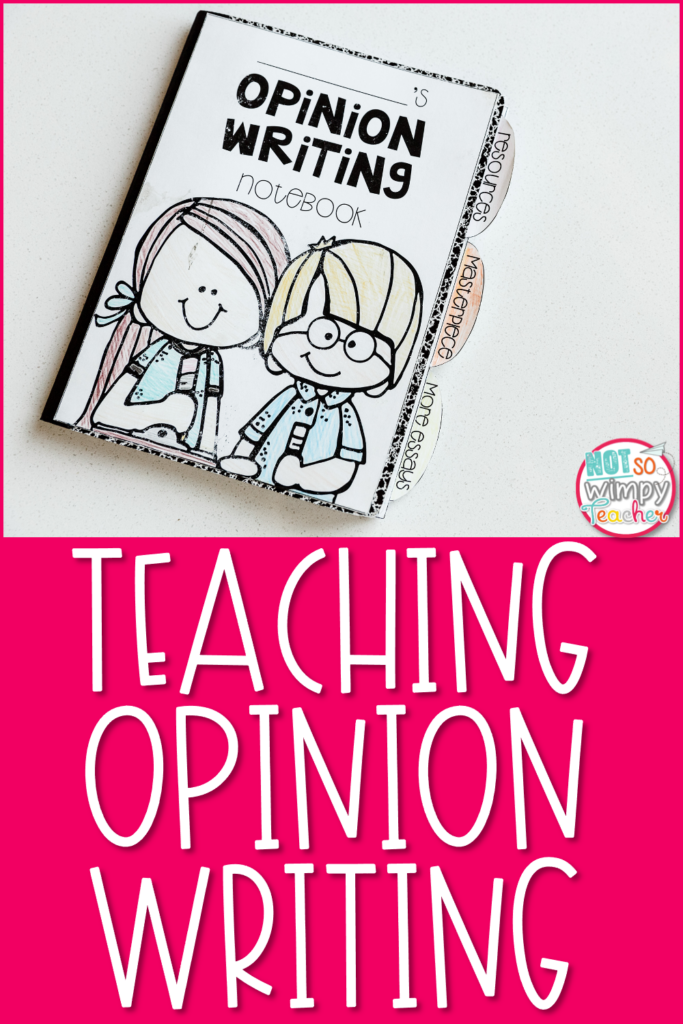
I hope you enjoy these tips for teaching opinion writing. You can also find tips for teaching personal narrative and informational report writing .
Have a Not So Wimpy Day,

You may also enjoy these posts
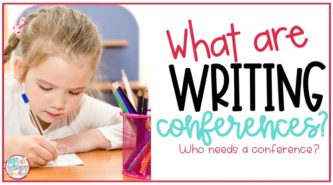
Reader Interactions
Leave a comment cancel reply.
Your email address will not be published. Required fields are marked *
Save my name, email, and website in this browser for the next time I comment.
More than 400 helpful resources available in my shop!
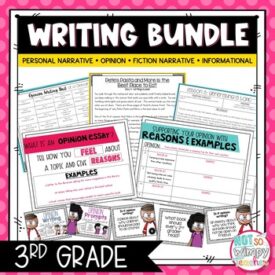

Not So Wimpy Writing Masterclass
Do you struggle to find time to teach writing? Do you find it a challenge to deliver lessons that help all of your writers? Would you like to learn a simple and effective way to teach writing? The Not So Wimpy Writing Masterclass is an online professional development course for grades 2-5. In this course, you will go from feeling overwhelmed to feeling confident and excited about teaching writing.
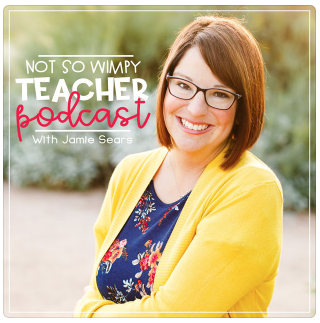
Check out these recent podcast episodes:
- Connecting with Students Online with Jennifer Serravallo
- A Simple Problem-Solving Strategy That Works Every Time
- Giving Students Feedback About Their Writing
- Virtual and Socially Distant Valentine’s Day Activities for the Classroom
- How to Use Project-Based Learning in the Classroom
Grab a snack and join the discussion over on Facebook!
We have four separate groups for grades 2-5
Get even more great tips and tricks on my YouTube channel!

We LOVE and recommend these products!
Check out the books, supplies, and other products that we use in our own classrooms. We only recommend those things that we absolutely love and swear by!

Hello! I’m Jamie
- I believe that students need to be the leaders of the classroom. Even third graders are old enough to be held accountable and to take responsibility for their learning.
- I do not believe that kids were made to sit in seats. They need to get up and move around.
- Differentiated instruction is a must. I use guided reading and guided math groups to meet the individual needs of my students.
- Helping a student to discover their love for reading is a privilege that I never get tired of.
- School should be fun! We party in my class!
Follow Me Here
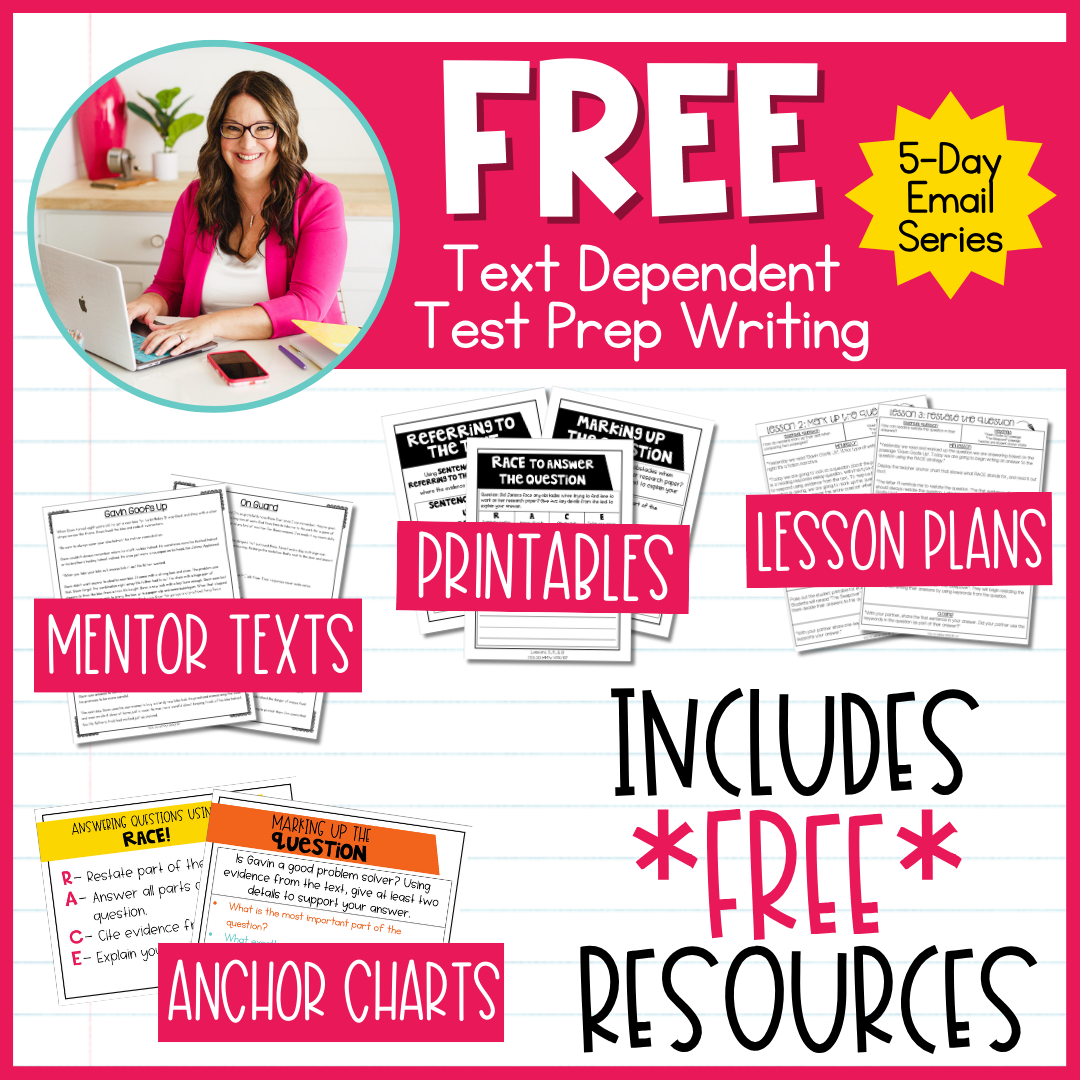

What Is An Argumentative Text? How to Teach It in 3rd Grade
You’ve spent hours scouring the internet and are about to pull your hair out and/or break your computer. You’re not alone.
Searching for resources to teach argumentative text can drive you crazy. There’s not a whole lot out there for it that’s appropriate for our third and fourth graders. Partially, I believe, this is because it’s just so dang hard to teach. And, it’s often confused as the same thing as persuasive text, which you can find resources for all over the place.
To teach it best, we need to start with our knowledge of it.
So, What Is Argumentative Text?
Before we do anything else, we need to be able to answer the question, “What is an argumentative text?” An argumentative text is a piece of writing in which the author states a claim, or position, and supports it with evidence to make the reader understand it as a valid argument.
The author relies on logic, facts, and credible sources to make his/her argument. This means that a lot of the real work begins before the author puts pen to paper with his/her thoughts. The actual starting place is in researching the topic. Then the author chooses a side or an argument.
Argumentative texts, especially those geared toward an audience above the age of 9, present the other side of the argument in the text. The author does this to show his/her fair-mindedness, but also to counter the argument with facts and evidence to show the reader that the author’s claim has more merit.
Basic Structure of Argumentative Text at the 3rd Grade Level

Understanding how an argumentative text is structured is extremely helpful in identifying the author’s claim. While there are different types of argumentative texts, and many can have a much more complex structure, below is a basic starting point for our third graders.
- Introduction – The author states or implies the claim.
- Body – The author supports the claim with reason, evidence, and facts.
- Conclusion – The author restates the claim.
Argumentative vs. Persuasive Text
Argumentative text and persuasive text are NOT the same thing. We should not be using these words interchangeably with our third graders. Click here to learn more about the differences between argumentative and persuasive text.
How do we teach argumentative text to our third graders?
Let’s start by looking at what the kids need to be able to do by the end of the unit:
- recognize the characteristics and structures of argumentative text,
- identify the claim,
- distinguish facts from opinions,
- and identify the intended audience.
- And, looking ahead to fourth grade, they will also need to be able to explain how the author used facts to support the argument.
Start with the Prerequisites
There are a couple of things that your students must be able to do before analyzing an argumentative text such as how to determine key ideas. Read more about the skills you want to practice before and during your argumentative text unit here .
Choose the Right Argumentative Text
Choose an appropriate high-interest text with a simple structure. Read more tips on how to find a great article here .
Here’s a free argumentative text for third grade:

Build Literacy Knowledge of Argumentative Text
It’s important to introduce the genre and its essential terms in an engaging way prior to reading. Get a free video to show your students here .
Create an anchor chart to give students a reference for the basic structure and characteristics of argumentative text. Read more about this here .
Get into the Text

This is where we’ll break down the actual lesson planning that goes into creating your unit. Below is a basic outline. You can find in-depth explanations in this blog post about how to teach argumentative text to third graders.
- Build Background Knowledge Before Reading the Argumentative Text
- Read & Discuss the Introduction and Claim
- Read & Discuss the Body and Supporting Evidence
- Read & Discuss the Conclusion
- Read & Discuss the References
- Determine the Intended Audience
- Analyze the Structure
- Evaluate the Author’s Claim
- Compare Argumentative Texts with the Same Topic
- Provide Student Practice
- Evaluate & Compare Arguments Made in the Same Text
- Assess Understanding
Want to Save Time? It’s All Done for You Here:

This bundle has everything you need to teach argumentative text to your third graders and lifts all the hard work off your shoulders. It is all planned and ready to go.
What You’ll Get:
- 5 easy to follow, scripted lesson plans take out all the guesswork.
- 3 of the 5 are PowerPoint lessons that make introducing the genre a breeze.
- A total of 7 high-interest passages will keep your students engaged.
- An assessment with an answer key is included.
- Interactive notebook pages help your students interact with the text and give them a tool to refer back to.
- Task cards help your students practice distinguishing fact from opinion and identifying evidence that supports the author’s claim.
- Plus, you’ll get resources for tier 2 vocabulary, grammar, and more!
Read More Details About All the Above:

Free Argumentative Text Passage for 3rd Grade

How to Teach Argumentative Text to 3rd Graders

Argumentative vs Persuasive Text: What’s the Difference?

Reading Comprehension Strategies That Will Help 3rd Graders Understand Argumentative Text

How to Introduce Argumentative Text to 3rd Graders
Pin it for later:.

I help third and fourth grade RLA teachers like you create engaging and effective reading lessons without all the stress.

Categories:
Affiliate links:, need help teaching figurative language.

Let me help out.
Get my figurative language free interactive notbook, other free resources, ideas, and tips no spam, just things you can use in your classroom., leave a reply cancel reply.
You must be logged in to post a comment.
MORE FROM THE BLOG:

9 Argumentative Text Example Articles You Can Confidently Use with Your Third Graders
Searching for good argumentative text examples that are age appropriate for third graders takes forever. Here are 9 great argumentative articles you can confidently use with your third graders.

Empowering ELA Teachers: 3 Effective Strategies for Supporting ELL Students
FacebookPin14EmailPrint You may not have been expecting the number of English language learners you have in your elementary classroom. However,

How To Host an Incredible Back to School Night and Impress Your Parents
FacebookPin24EmailPrint Back to school night, meet the teacher night, open house, whatever you call it. It sets the tone for

8 Simple and Fun Icebreaker Games for Kids to Use During Back to School Season
FacebookPin18EmailPrint You likely have a thousand things to do to prepare for the first week of school and creating new,

Make STAAR Reading Review Fun with the Task Cards You Already Have
Facebook26Pin36EmailPrint You want to make STAAR Reading review fun, but you’re tired of spending every dollar you earn on your
FacebookPin4EmailPrint I love using videos to grab my students’ attention. I don’t usually use anything too long, a quick video
Copyright 2021 | Cultivating Critical Readers, LLC | All Rights Reserved
3rd grade writing
by: Jessica Kelmon | Updated: August 4, 2022
Print article

This year, your child’s stories will amaze you, showing character development and dialogue. Your child’s opinion pieces and informational writing will be more organized. With this new writing prowess, your child will be using more sophisticated language and better grammar.
Building 3rd grade study skills
Third graders are expected to use books, websites, and other digital sources to do research projects and to build knowledge about different topics — both on their own and as part of group work with their peers. But there’s a new skill to learn this year: taking notes. Third graders need to start writing down what they learn from each source they use, keeping track of the source name and page so they are able to find it again, and then practice sorting any evidence they find into relevant categories.
3rd grade opinion pieces
Of course your child has an opinion — and here’s how they learn to share it in writing! Opinion pieces will likely start with your child reading a couple of books and responding to what they’ve learned. Your child should start their opinion piece by clearly introducing the topic, stating their opinion, and then giving multiple reasons to support their opinion. Kids should practice using linking words (e.g. because, therefore, since, for example ) to connect their reasons to their opinion, and then end their writing with a conclusion.
3rd grade informative writing
The purpose of informative writing is to convey facts and ideas clearly. After introducing their topic, kids should group related information into a few clear, well thought-out points. They should develop these points using facts, definitions, and details and using linking words (e.g. also, another, and, more, but ) to connect their ideas within each point. Your child can also include illustrations when they may help make or clarify a point. Finally, kids should end their work with a concluding sentence or two.
Can your 3rd grader write an informational essay?

3rd grade narrative writing
Narrative is just a fancy word for story — and this year your child’s stories will be much more complex. Using a narrator, characters, dialogue, and descriptive details, your third grader’s writing should show a story unfolding — including how the characters feel and respond to what happens. The sequence of events should be clear. Be sure not to let your child’s story simply stop by writing “The End”. Instead, the story should read like it’s coming to a close.
Check out this related worksheet: • How to write a story
bttr, better, best!
Expect to see your child spending more time writing this year, whether it’s in the planning, writing, revising, or editing phase. While planning , your child may read or reread books on the topic, discuss their ideas aloud, brainstorm ideas, gather and organize information visually, jot down notes about the points they’ll make, and start to think about the structure of the piece. Once a first draft is in, the teacher or other students will go over it with your child. They’ll ask questions and suggest details or facts that could be added, clarified, or improved. Do the word choices convey what your child really meant? Is there an introduction and a conclusion? Are the story’s events in order? Using all these questions and suggestions as guidance, your child will do a revision , adding to, reordering, and improving the content. After one or more revisions, the teacher might help your child with the final edit — focusing on spelling and grammar, capitalizing proper nouns, ensuring nouns and verbs are in agreement, and checking that periods, commas, and quotation marks are used correctly. Following these steps — planning, writing a first draft, revising their work, and editing the final piece — teaches third graders that gathering information, organizing their thoughts, strengthening and clarifying their ideas, and improving grammar and presentation are all key to quality writing.
See what 3rd grade writing looks like

A red-letter year for grammar!
This year your child will learn the functions of nouns, pronouns, verbs, adjectives, and adverbs — and what role they play in a sentence. By year’s end, your child should be using regular and irregular verbs in simple past, present, and future tense (e.g. stopped/stop/will stop and knew/know/will know ) — all while ensuring subject-verb agreement (e.g. I know/he knows ). Your child should also use comparative adjectives and adverbs (e.g. big/bigger/biggest and quickly/quicker/quickest ) and choose between them based on whether they’re modifying nouns (adjectives) or verbs (adverbs). In writing compound and complex sentences, your child will use conjunctions that show connection (e.g. and, or, but ) and dependence (e.g. if, when, because ).
Check out these related worksheets: • Big, bigger, biggest • Verb machine! • 3rd grade spelling list #15: irregular plural nouns
Third graders should use increasingly precise words. This means understanding root words (e.g. knowing that add is the root of addition and additional ), choosing the right word from synonyms (e.g. knew, believed, suspected, heard, wondered ), and using words to signal timing (e.g. after, then, later ). With all this focus on word nuance, your child may need a thesaurus handy.
Related: Print this list of 3rd grade academic vocabulary words .
Check out these related worksheets: • 3rd grade weekly spelling lists • Prefix practice • Writing practice: alternatives to “said”
And it’s live!
When the research is done — and the planning, writing, revisions, and edits are complete — the final step for some of your third grader’s writing is to publish the work. Your third grader should have some keyboarding skills by the end of the year. It’s a new level of independence and tech savvy. And while adults should be there to help out, your child should become comfortable taking the lead.
What about cursive?
Penmanship matters. Traditionally, third grade is when students learn cursive, so it’s a great idea to ask the teacher whether or not they’ll be learning cursive in class. If not, you may want to work on this skill with your child at home.
Updated August 2022
Homes Nearby
Homes for rent and sale near schools

6 ways to improve a college essay

Quick writing tips for every age

Writing on the wall
Why parents must teach writing
Yes! Sign me up for updates relevant to my child's grade.
Please enter a valid email address
Thank you for signing up!
Server Issue: Please try again later. Sorry for the inconvenience
- Skip to primary navigation
- Skip to main content
- Skip to primary sidebar
- Skip to footer

Thrifty in Third Grade
By Cassie Smith - Teaching resources and blog posts for second, third, fourth, and fifth grade!
Easy Ways to Introduce Opinion Writing
It sounds simple and straightforward, but the easiest way to begin an opinion writing unit is to teach your students to have opinions!

There are several fun ways to teach your students to have opinions.
Incorporate Math
Graphing is a perfect skill to integrate with your writing standards. In this case, you can ask students their favorite (animal, sport, etc…) and graph the class results. Students can collect data and can write simple opinion statements.
Incorporate Reading
When you are teaching the author’s point of view, you can incorporate opinion writing!
It’s as simple as teaching your students to agree or disagree with the author’s opinion!
Learn more about teaching point of view here .
Would You Rather?
This is a fun game you can play and you can get your whole class moving. Begin by having your class line up in a central location. Have two designated places for students to move for choice A and B.
Then, pose questions. Based on their preference, they’ll move to side A or side B.
Would You Rather Questions:
- Would you rather stub your toe or get a paper cut?
- Travel on a sailboat or travel on an airplane?
- Have extra recess or extra technology time?
- Have pizza for lunch or nachos?
- Play a board game with your family or watch a movie with your family?
Stumped on question ideas? Have your students each write one! Then, you can simply read them.
Opinion Statement Sort
After students have spent time learning what it means to have an opinion, you can move on to teaching them to write opinion statements .

Once students have learned to write an opinion statement, they are ready to move on to writing an opinion paragraph.
O-R-E-O Paragraphs
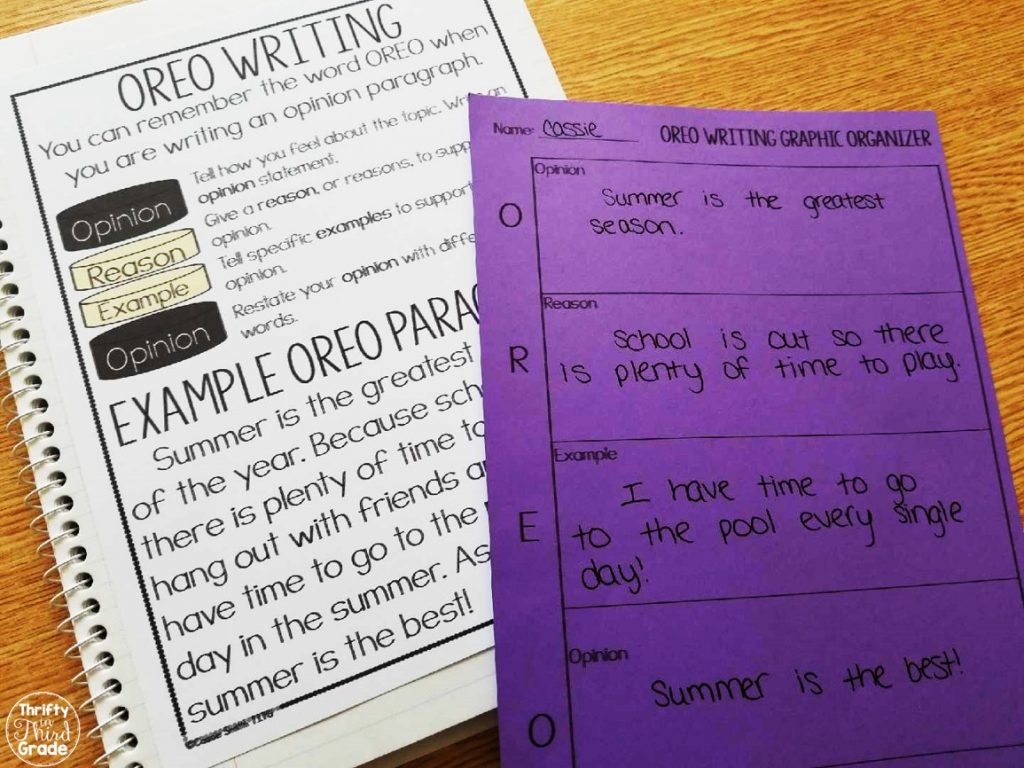
You’ve probably heard of O-R-E-O writing before, but if you haven’t, it’s a fun way to teach students how to write an opinion paragraph.
Students begin by writing their opinion statement (O), then give a reason (R), an example (E), and restate their opinion (O).
This is a very basic structure that you can use for introducing opinion writing. From there, you’ll want to teach your students how to write an opinion essay!
Check out my Opinion Piece Writing Units (Grades 2-5)! These come in both print and Google Slides formats!

Looking for more blog posts about teaching writing? Check out these!
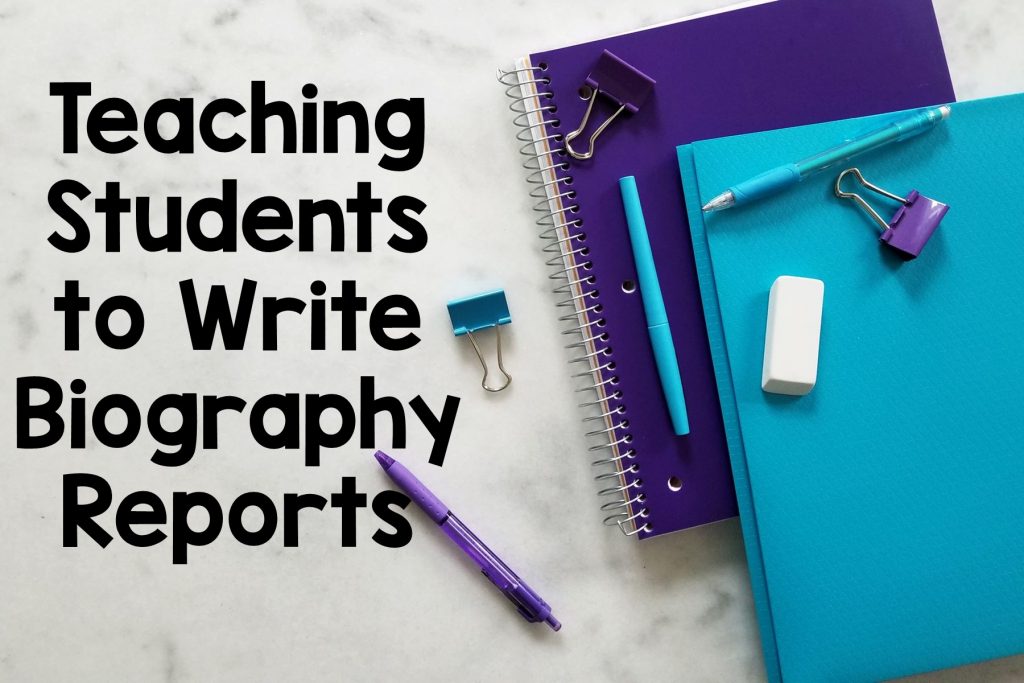
Reader Interactions
January 10, 2022 at 6:15 pm
Thank you so much. You don’t know how much this helps me. I’m a mom trying to help my child with homework. Again, I really appreciate this ?
Meet Cassie
I’m Cassie Smith and I’m so glad you decided to stop by. I am passionate about creating engaging curriculum for teachers in grades K-5! I believe learning can be fun AND aligned to standards! Learn More
Looking for something?
- About Cassie
- ABCs of Salvation
- Privacy Policy
- Terms of Use
- Disclaimers
Let’s Connect
Get support.
Come join our Elementary Teachers Support Group on Facebook! You’ll be able to collaborate and get tips from thousands of teachers just like you!
Get a Surprise!
Sign up for our email list and we'll send a surprise freebie right to your inbox!
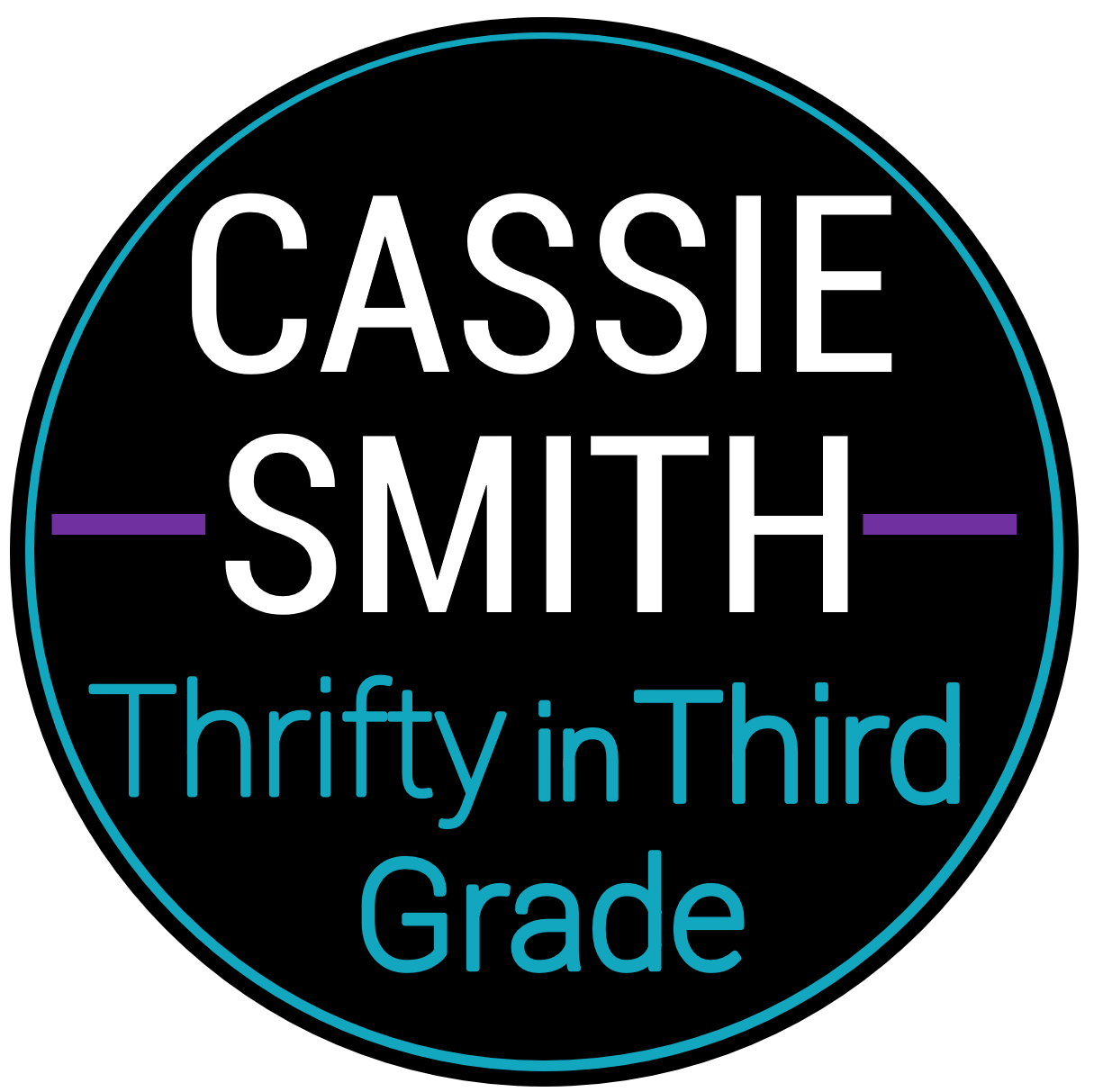

How to Write an Expository Essay for Grade Three

How to Make an Outline for a Fourth Grade Research Paper
Third grade is often the year when students first begin to experiment with structured writing, such as the expository essay. Writing an expository essay in third grade is a lot like making a sandwich. Just as a good sandwich has three parts -- the top bun, fillings and bottom bun -- a good expository essay also has three parts: the introduction, details and conclusion.
Choose a Topic

You write an expository essay to tell or teach the reader about a topic. Start by choosing a topic that you think is interesting and that you already know a lot about. You might choose to write about an animal you like, a place you have visited or a person whom you have read about. If you have too many ideas, make a list and then close your eyes and pick.
Do Some Research

Research is when you look for more information on a topic. Start your research by choosing and reading a book about your topic. Pick a book that is nonfiction, as it will have factual information that you can use in your essay. As you read, take notes. Use a notebook to copy down the facts that you think are most important and to write down questions that you have. You will refer to these notes as you write your essay.
Write the Introduction
The beginning of your expository essay is your introduction -- where you capture the reader's attention and tell her what the main idea of the essay is going to be. Make the introduction as interesting as possible so that the reader wants to keep reading. A good way to start an introduction is with a question or with an amazing fact. For example: "Did you know that great white sharks can eat up to 11 tons of food a year? Sharks are amazing and important fish."
Add Some Details
Once you have hooked the reader's attention, tell him more about your topic. Details are individual facts that provide more information about a topic. The best details give sensory information. That means that they give more information that helps your reader imagine how things feel, smell, sound, taste or look. Try to include at least three details in your expository essay. For example: "Sharks might look smooth when they are in the water, but their skin is actually very rough. Sharks are often called silent hunters, because the only sounds they make are crunching sounds -- after they've caught their prey."
Write a Conclusion
The final part of your expository essay is the conclusion where you return to the main idea of your essay and restate it in different words. The conclusion helps tie the whole essay together and reminds the reader of the most important points. Conclusions often start with phrases like "in conclusion," "as you can see," "finally" or "in the end."
Proofread Your Work

If you wrote your essay on paper, reread it and look for spelling, punctuation and capital letter mistakes. If you find any, fix them. If you wrote your essay on the computer, print out a copy and read it on paper, looking for the same kinds of mistakes. Before you hand in your work, check that your name is on the paper. You want to get credit for the hard work you did.
Related Articles

How to Write an Anecdotal Essay

How to Stay on Topic When Writing an Essay

How to Write a Dissertation Summary

How Do Reflective Essays Differ From Analytical Essays?

How to Write a Scholarship Letter

How to Pair a Wrap Dress With Boots

What Is a Descriptive Paragraph?

How to Add Figurative Language to an Essay
A lifetime resident of New York, Christi O'Donnell has been writing about education since 2003. O'Donnell is a dual-certified educator with experience writing curriculum and teaching grades preK through 12. She holds a Bachelors Degree from Sarah Lawrence College and a Masters Degree in education from Mercy College.

Essay Writing: A complete guide for students and teachers
P LANNING, PARAGRAPHING AND POLISHING: FINE-TUNING THE PERFECT ESSAY
Essay writing is an essential skill for every student. Whether writing a particular academic essay (such as persuasive, narrative, descriptive, or expository) or a timed exam essay, the key to getting good at writing is to write. Creating opportunities for our students to engage in extended writing activities will go a long way to helping them improve their skills as scribes.
But, putting the hours in alone will not be enough to attain the highest levels in essay writing. Practice must be meaningful. Once students have a broad overview of how to structure the various types of essays, they are ready to narrow in on the minor details that will enable them to fine-tune their work as a lean vehicle of their thoughts and ideas.

In this article, we will drill down to some aspects that will assist students in taking their essay writing skills up a notch. Many ideas and activities can be integrated into broader lesson plans based on essay writing. Often, though, they will work effectively in isolation – just as athletes isolate physical movements to drill that are relevant to their sport. When these movements become second nature, they can be repeated naturally in the context of the game or in our case, the writing of the essay.
THE ULTIMATE NONFICTION WRITING TEACHING RESOURCE

- 270 pages of the most effective teaching strategies
- 50+ digital tools ready right out of the box
- 75 editable resources for student differentiation
- Loads of tricks and tips to add to your teaching tool bag
- All explanations are reinforced with concrete examples.
- Links to high-quality video tutorials
- Clear objectives easy to match to the demands of your curriculum
Planning an essay

The Boys Scouts’ motto is famously ‘Be Prepared’. It’s a solid motto that can be applied to most aspects of life; essay writing is no different. Given the purpose of an essay is generally to present a logical and reasoned argument, investing time in organising arguments, ideas, and structure would seem to be time well spent.
Given that essays can take a wide range of forms and that we all have our own individual approaches to writing, it stands to reason that there will be no single best approach to the planning stage of essay writing. That said, there are several helpful hints and techniques we can share with our students to help them wrestle their ideas into a writable form. Let’s take a look at a few of the best of these:
BREAK THE QUESTION DOWN: UNDERSTAND YOUR ESSAY TOPIC.
Whether students are tackling an assignment that you have set for them in class or responding to an essay prompt in an exam situation, they should get into the habit of analyzing the nature of the task. To do this, they should unravel the question’s meaning or prompt. Students can practice this in class by responding to various essay titles, questions, and prompts, thereby gaining valuable experience breaking these down.
Have students work in groups to underline and dissect the keywords and phrases and discuss what exactly is being asked of them in the task. Are they being asked to discuss, describe, persuade, or explain? Understanding the exact nature of the task is crucial before going any further in the planning process, never mind the writing process .
BRAINSTORM AND MIND MAP WHAT YOU KNOW:
Once students have understood what the essay task asks them, they should consider what they know about the topic and, often, how they feel about it. When teaching essay writing, we so often emphasize that it is about expressing our opinions on things, but for our younger students what they think about something isn’t always obvious, even to themselves.
Brainstorming and mind-mapping what they know about a topic offers them an opportunity to uncover not just what they already know about a topic, but also gives them a chance to reveal to themselves what they think about the topic. This will help guide them in structuring their research and, later, the essay they will write . When writing an essay in an exam context, this may be the only ‘research’ the student can undertake before the writing, so practicing this will be even more important.
RESEARCH YOUR ESSAY
The previous step above should reveal to students the general direction their research will take. With the ubiquitousness of the internet, gone are the days of students relying on a single well-thumbed encyclopaedia from the school library as their sole authoritative source in their essay. If anything, the real problem for our students today is narrowing down their sources to a manageable number. Students should use the information from the previous step to help here. At this stage, it is important that they:
● Ensure the research material is directly relevant to the essay task
● Record in detail the sources of the information that they will use in their essay
● Engage with the material personally by asking questions and challenging their own biases
● Identify the key points that will be made in their essay
● Group ideas, counterarguments, and opinions together
● Identify the overarching argument they will make in their own essay.
Once these stages have been completed the student is ready to organise their points into a logical order.
WRITING YOUR ESSAY
There are a number of ways for students to organize their points in preparation for writing. They can use graphic organizers , post-it notes, or any number of available writing apps. The important thing for them to consider here is that their points should follow a logical progression. This progression of their argument will be expressed in the form of body paragraphs that will inform the structure of their finished essay.
The number of paragraphs contained in an essay will depend on a number of factors such as word limits, time limits, the complexity of the question etc. Regardless of the essay’s length, students should ensure their essay follows the Rule of Three in that every essay they write contains an introduction, body paragraphs, and a conclusion.
Generally speaking, essay paragraphs will focus on one main idea that is usually expressed in a topic sentence that is followed by a series of supporting sentences that bolster that main idea. The first and final sentences are of the most significance here with the first sentence of a paragraph making the point to the reader and the final sentence of the paragraph making the overall relevance to the essay’s argument crystal clear.
Though students will most likely be familiar with the broad generic structure of essays, it is worth investing time to ensure they have a clear conception of how each part of the essay works, that is, of the exact nature of the task it performs. Let’s review:
Common Essay Structure
Introduction: Provides the reader with context for the essay. It states the broad argument that the essay will make and informs the reader of the writer’s general perspective and approach to the question.
Body Paragraphs: These are the ‘meat’ of the essay and lay out the argument stated in the introduction point by point with supporting evidence.
Conclusion: Usually, the conclusion will restate the central argument while summarising the essay’s main supporting reasons before linking everything back to the original question.
ESSAY WRITING PARAGRAPH WRITING TIPS

● Each paragraph should focus on a single main idea
● Paragraphs should follow a logical sequence; students should group similar ideas together to avoid incoherence
● Paragraphs should be denoted consistently; students should choose either to indent or skip a line
● Transition words and phrases such as alternatively , consequently , in contrast should be used to give flow and provide a bridge between paragraphs.
HOW TO EDIT AN ESSAY

Students shouldn’t expect their essays to emerge from the writing process perfectly formed. Except in exam situations and the like, thorough editing is an essential aspect in the writing process.
Often, students struggle with this aspect of the process the most. After spending hours of effort on planning, research, and writing the first draft, students can be reluctant to go back over the same terrain they have so recently travelled. It is important at this point to give them some helpful guidelines to help them to know what to look out for. The following tips will provide just such help:
One Piece at a Time: There is a lot to look out for in the editing process and often students overlook aspects as they try to juggle too many balls during the process. One effective strategy to combat this is for students to perform a number of rounds of editing with each focusing on a different aspect. For example, the first round could focus on content, the second round on looking out for word repetition (use a thesaurus to help here), with the third attending to spelling and grammar.
Sum It Up: When reviewing the paragraphs they have written, a good starting point is for students to read each paragraph and attempt to sum up its main point in a single line. If this is not possible, their readers will most likely have difficulty following their train of thought too and the paragraph needs to be overhauled.
Let It Breathe: When possible, encourage students to allow some time for their essay to ‘breathe’ before returning to it for editing purposes. This may require some skilful time management on the part of the student, for example, a student rush-writing the night before the deadline does not lend itself to effective editing. Fresh eyes are one of the sharpest tools in the writer’s toolbox.
Read It Aloud: This time-tested editing method is a great way for students to identify mistakes and typos in their work. We tend to read things more slowly when reading aloud giving us the time to spot errors. Also, when we read silently our minds can often fill in the gaps or gloss over the mistakes that will become apparent when we read out loud.
Phone a Friend: Peer editing is another great way to identify errors that our brains may miss when reading our own work. Encourage students to partner up for a little ‘you scratch my back, I scratch yours’.
Use Tech Tools: We need to ensure our students have the mental tools to edit their own work and for this they will need a good grasp of English grammar and punctuation. However, there are also a wealth of tech tools such as spellcheck and grammar checks that can offer a great once-over option to catch anything students may have missed in earlier editing rounds.

Putting the Jewels on Display: While some struggle to edit, others struggle to let go. There comes a point when it is time for students to release their work to the reader. They must learn to relinquish control after the creation is complete. This will be much easier to achieve if the student feels that they have done everything in their control to ensure their essay is representative of the best of their abilities and if they have followed the advice here, they should be confident they have done so.
WRITING CHECKLISTS FOR ALL TEXT TYPES

⭐⭐⭐⭐⭐ (92 Reviews)
ESSAY WRITING video tutorials


- All topics A-Z
- Grammar
- Vocabulary
- Speaking
- Reading
- Listening
- Writing
- Pronunciation
- Virtual Classroom
- Worksheets by season
- 600 Creative Writing Prompts
- Warmers, fillers & ice-breakers
- Coloring pages to print
- Flashcards
- Classroom management worksheets
- Emergency worksheets
- Revision worksheets
- Resources we recommend
- Copyright 2007-2021 пїЅ
- Submit a worksheet
- Mobile version

How to Teach Informative Writing
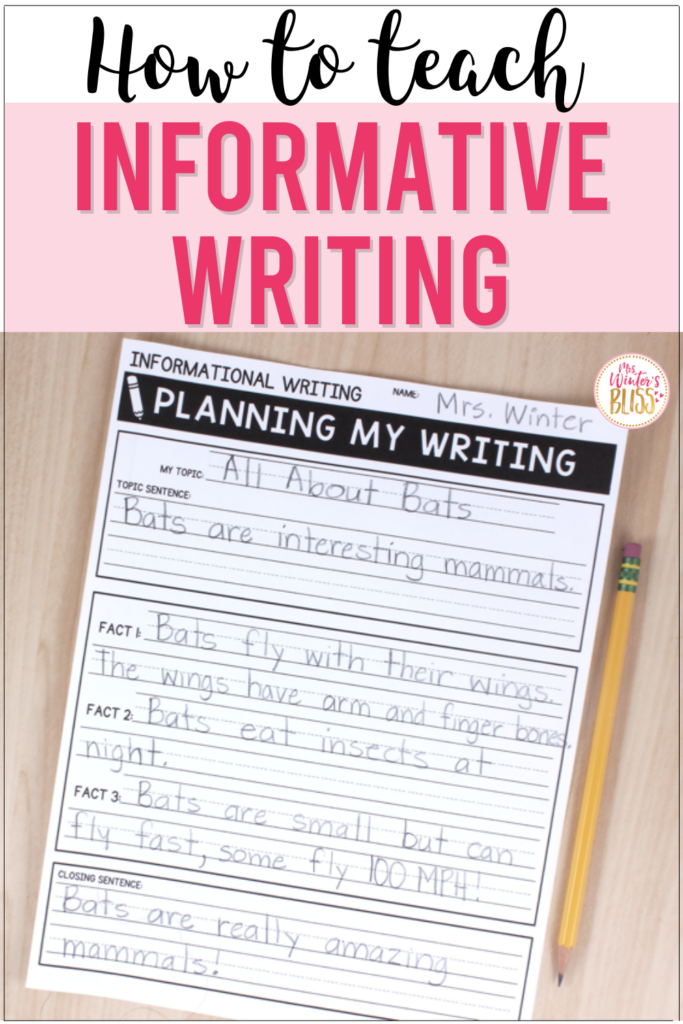
n this post, I share 5 tips for How to Teach Informative Writing and provide details about my Informational Writing Unit resources for for Kindergarten, 1st and 2nd grade students. Be sure to download 3 FREE Informational Writing Graphic Organizers!
We write for a variety of purposes. The most popular are to inform, entertain, explain, or persuade. While we teach our students to write for each of these different purposes, the ability to effectively write an informative piece of writing is a highly important skill for students to learn. It is one of the most common types of writing we use in our everyday lives.

Today I’m excited to share 5 tips for teaching informational writing, as well as a valuable resource that has everything you need to teach informative writing to your kindergarten , first grade , or second grade students!
1. Read Informative Writing Mentor Texts
As a teacher, you may “Start with the end in mind” when you plan out your units of study, but it also applies to students learning about different genres of writing. Before you can ask your students to write in a genre that is new to them, you must first immerse them in it.
So to begin your informational writing unit, you’ll want to share lots of quality informational texts with your students. These mentor texts provide students with excellent examples of informational writing. As you read them aloud, highlight the way the author structures their writing and the features they include to help make their writing more clear for the reader. All of these things will help students better understand what type of writing we are asking them to do.

When you’re picking informative mentor texts to share with your students there are a few things to consider . First, do you (the educator) think it is excellent? Second, is it easy for your students to understand? And finally, is it relevant to the type of writing you are teaching? If you answer “Yes!” to all three, then you’re good to go!
To help you out I’ve created a list of excellent mentor texts you can use when teaching Informative Writing to kindergarten, first, or second grade students.
A List of Informative Writing Mentor Texts:
Gail Gibbons
- The Moon Book
- The Pumpkin Book
Nicola Davies
- One Tiny Turtle
- Big Blue Whale
- Bat Loves the Night
- Surprising Sharks
Jim Arnosky
- Slither and Crawl
- Frozen Wild
- Beachcombing: Exploring the Seashore
Diana Aston
- An Egg is Quiet
- A Beetle is Shy
- A Seed is Sleepy
- A Rock is Lively
I’ve saved all these titles on one board so you can easily take a closer look at these mentor texts. Click here to see this list on Amazon .
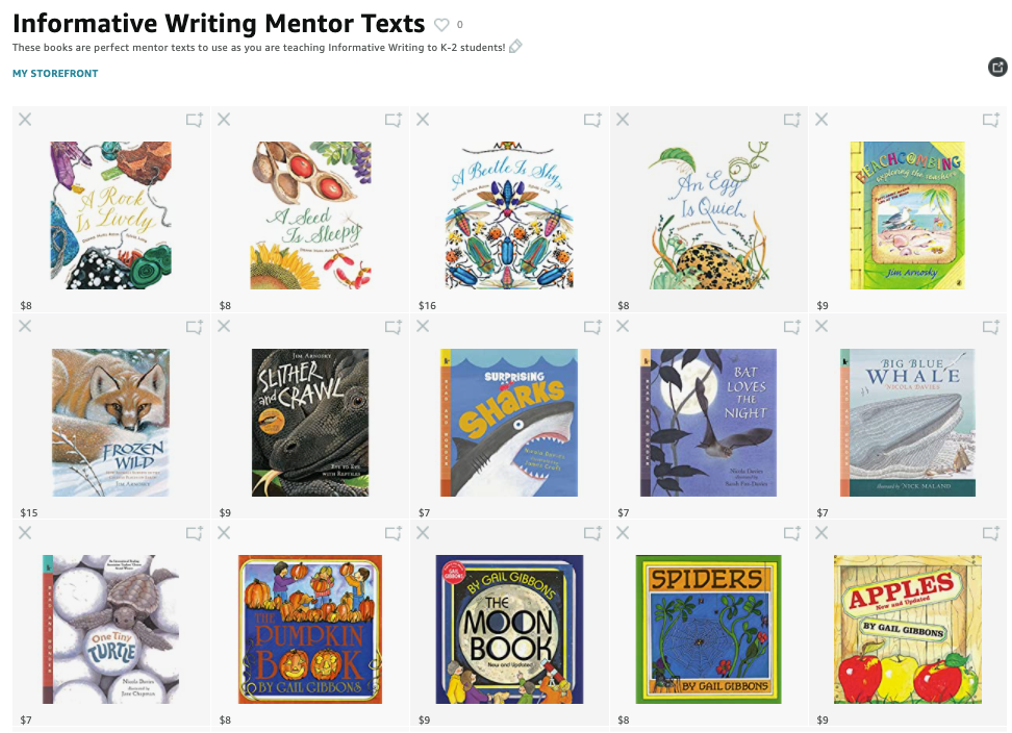
2. Model Your Own Informational Writing
Never underestimate the importance of modeling! It’s the most powerful tool in your arsenal.
When teaching informative writing first model how to choose a topic. Picking a topic is fun and easy because you get to choose something you already know a lot about!
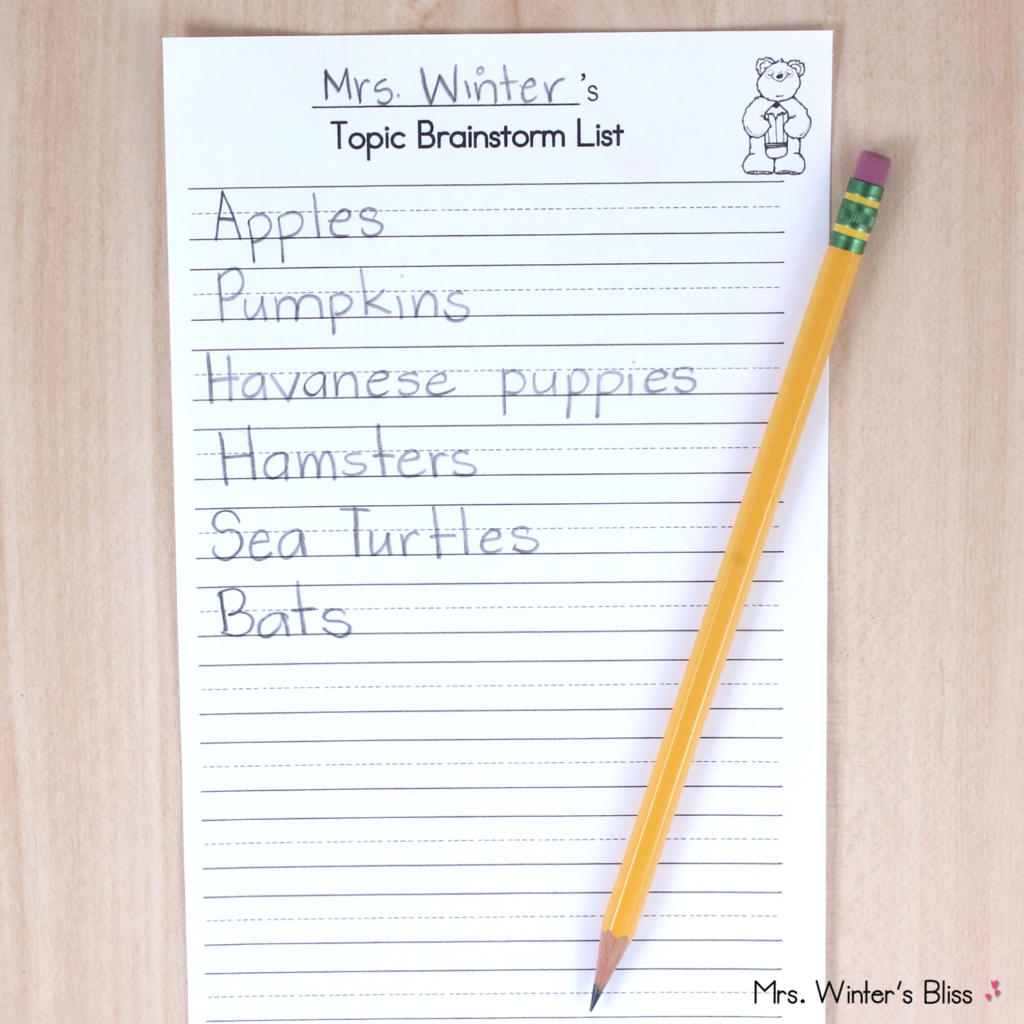
Remind students that they are already experts in so many areas!! This can be a big confidence booster for kids who might normally struggle to come up with ideas to write about. Use think alouds to show them how you brainstorm a list of topics you already know a lot about and show them how you narrow it down to one.
Next, model how you gather information and organize your ideas. For informative writing you can show them how you use your prior knowledge, as well as pull important information from outside resources like books and websites.
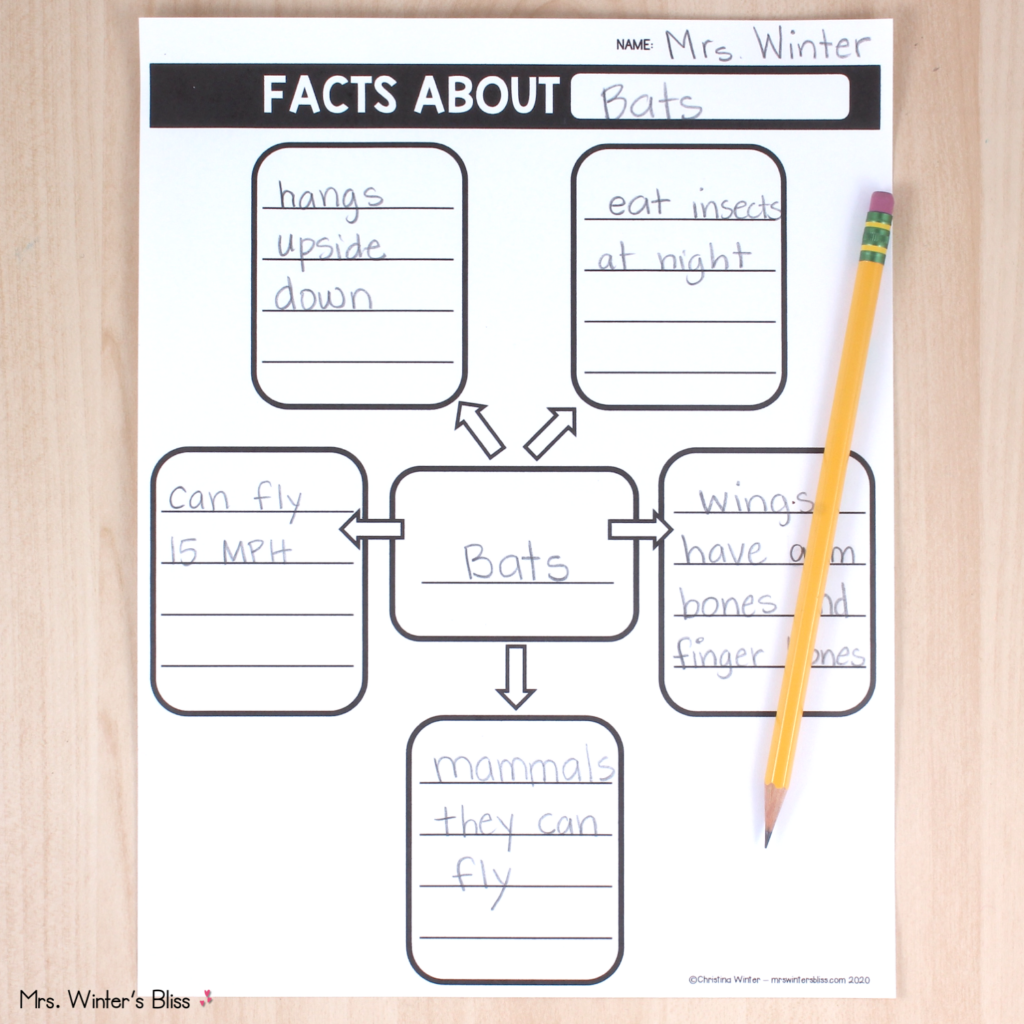
Finally, reread your work aloud and show students how you catch silly mistakes such as spelling, capitalization or punctuation errors. You can also show how you add more details to make your piece more informative for your reader.
3. Use Anchor Charts
You want your students to know that when they write an informative piece they are sharing facts, or true information, with their reader. They are not sharing their opinion. It is important to take time to review fact vs. opinion with your students. You can create an anchor chart that clearly defines fact vs. opinion and then practice determining if different statements are facts or opinions.
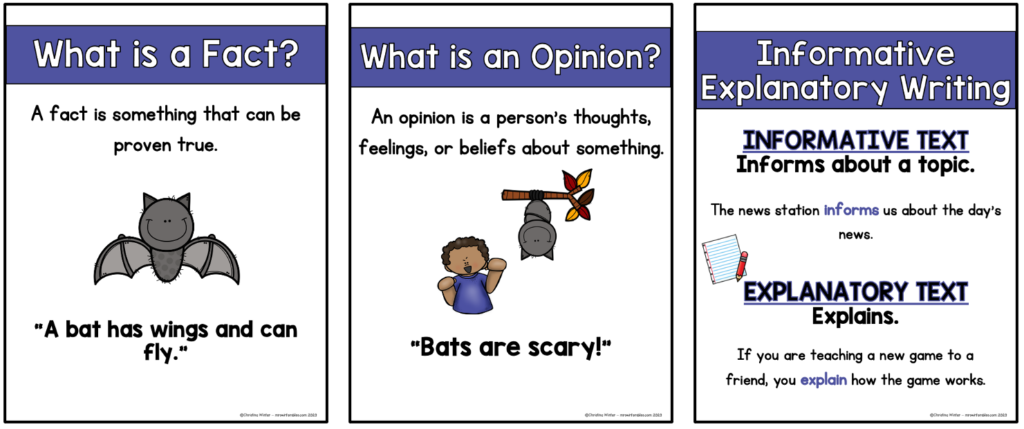
You will also want to create an anchor chart using the writing you model. This will serve as another example of excellent informative writing. As a class, add labels to identify the topic sentence, supporting facts/details and the closing sentence in your shared writing.
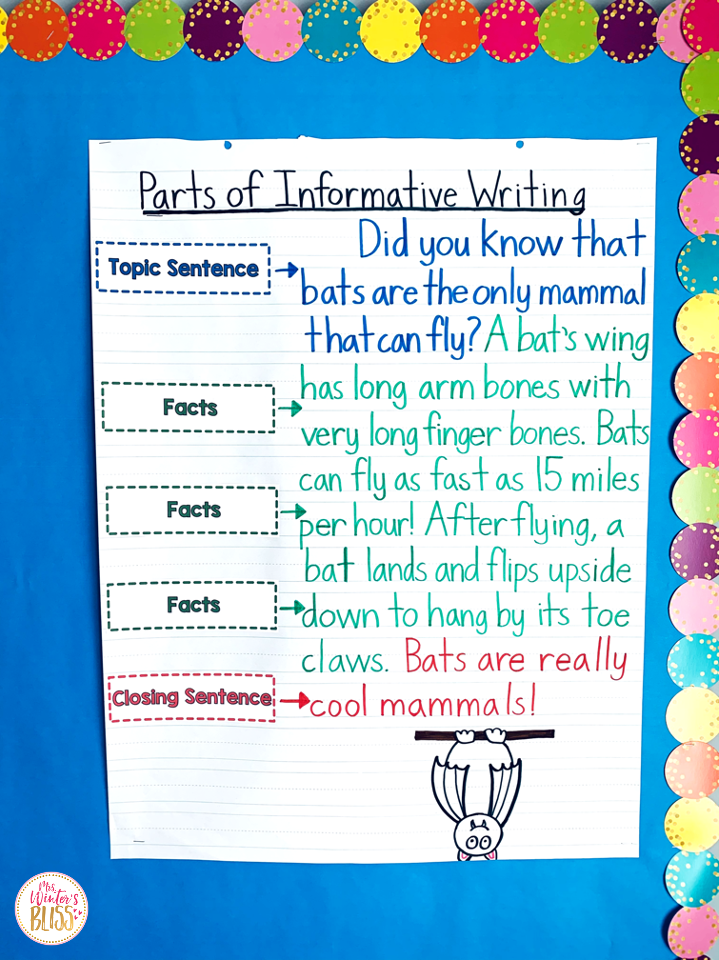
Post these anchor charts in your writing center so your students can refer back to them and use them as support as they write their own pieces.
4. Allow students to edit and share their writing
Provide a good writers checklist at your writing center. For informative writing you’ll want the checklist to include items such, “Does my writing have a topic sentence?” “Did I include enough facts?” and “Do I have a closing sentence?”, as well reminders to check for spelling, capitalization, and punctuation errors.
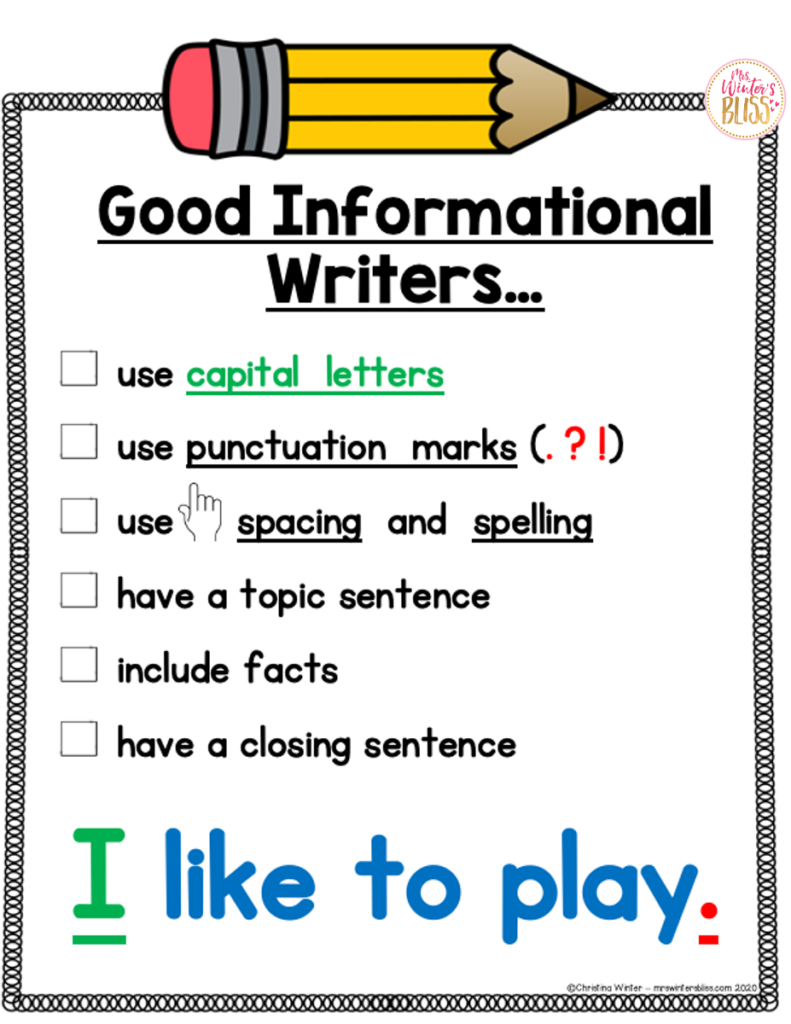
Give students the opportunity to share their writing with others! Pair students with partners and let them read their pieces to each other.

You can teach them to provide each other with a bit of feedback by encouraging them to use sentence starters such as, “I like the way you….:” , “I learned that….” or “Your writing made me wonder….”. Of course, this is also something you’d first want to model. Posting these sentence starters in your writing center provides support and helps to keep students focused and on-task.
5. Provide Daily Opportunities for Students to Write
As with all things, writing takes PRACTICE! Informative writing requires students to do a lot of hard work. It requires that they think carefully about their purpose for writing. Then they must plan what they’ll say and how they’ll say it.
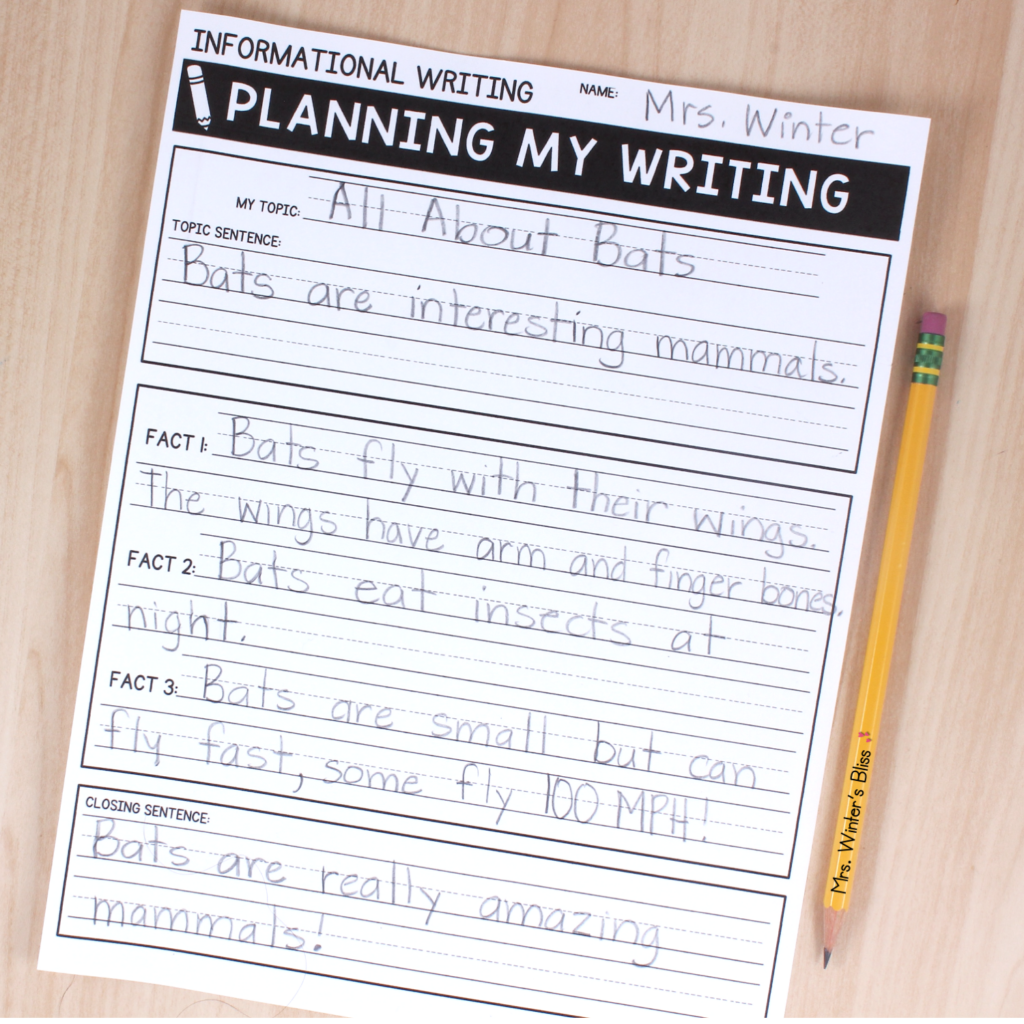
Finally, they’ve got to get it down on the paper in a way that is clear for the reader. That’s a lot for a young child!
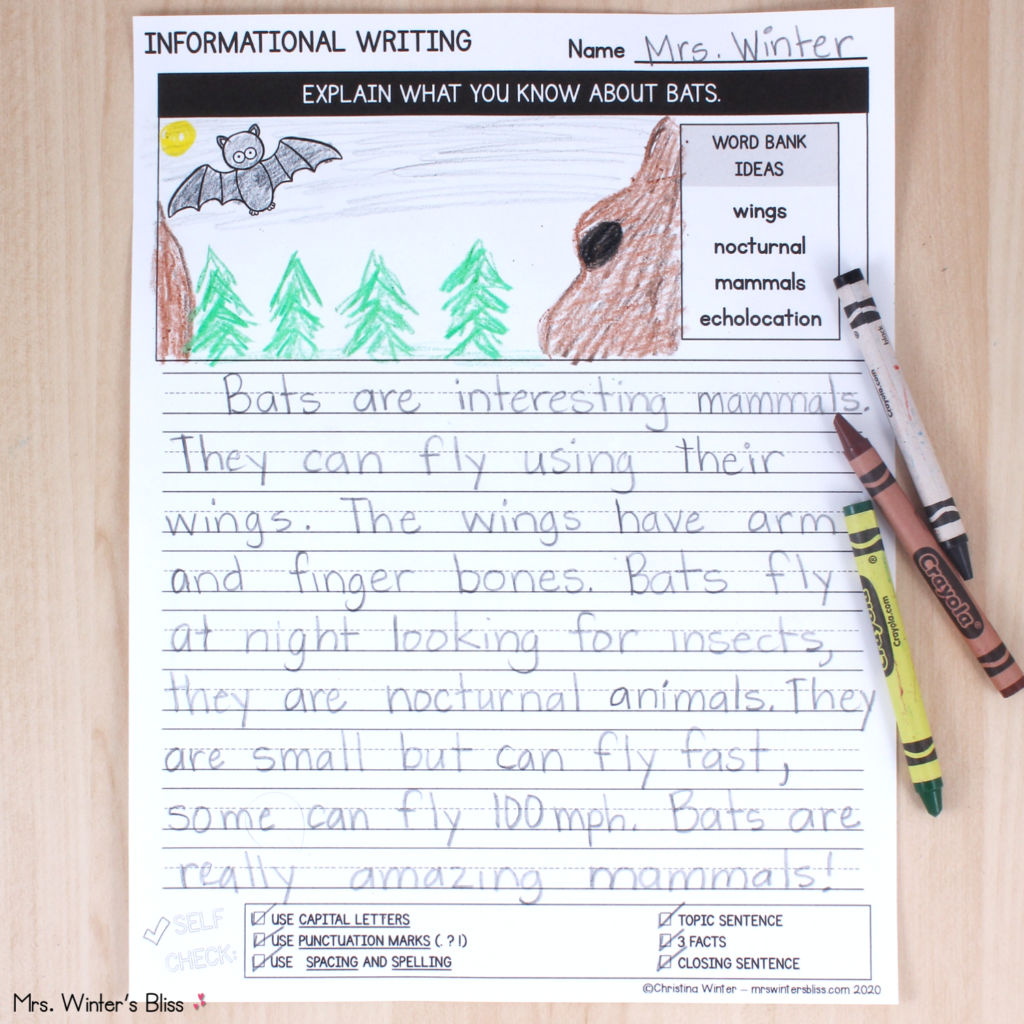
Students need dedicated instructional time to learn the skills and strategies necessary to become effective writers, as well as time to practice what they learn. When you think about your daily instructional schedule, make sure you are giving your students ample opportunities to practice their informational writing through whole group instruction, small groups and/or through independent practice in writing centers.
Informative Writing Unit For Kindergarten, First, and Second Grade Students
We know informational writing requires a lot from students, but planning these informative writing units is also A LOT of work for you as the teacher!
To help you out I created informative writing units that have the essential resources you need to teach and students to independently practice informational writing! These units are a perfect addition to your literacy work in writing centers.
Today I’m excited to share with you the details about my Kindergarten Informative , 1st Grade Informative, and my 2nd grade Informative writing units!
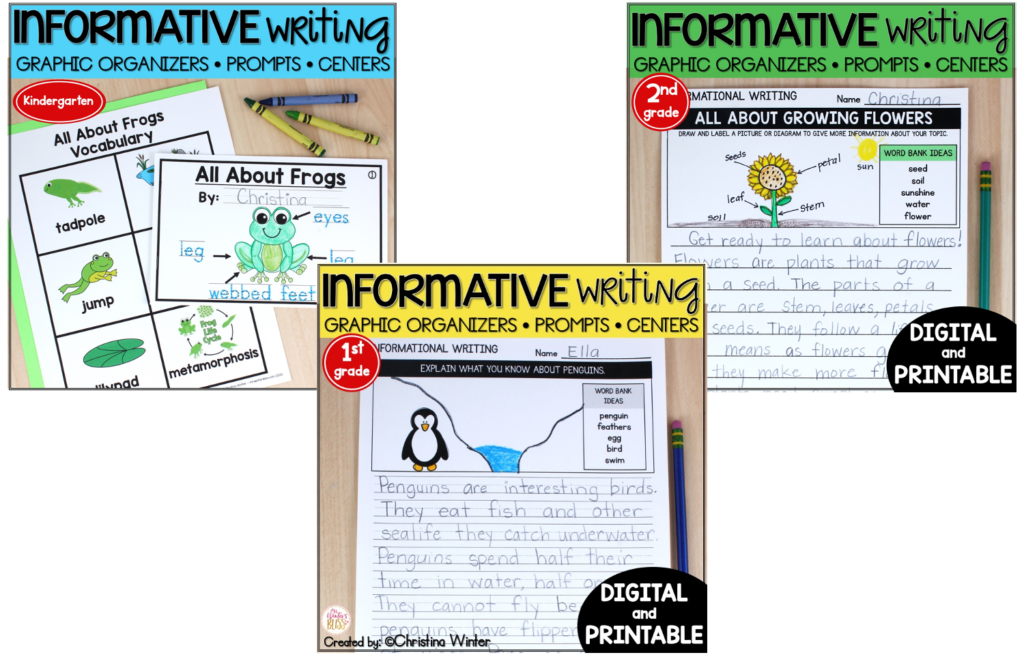
These units were developed with standards-based research specific to each grade. They have EVERYTHING you need to give your students ample amounts of practice writing informational pieces. You can use them within whole class or small group lessons, or as a literacy center where students can practice independently!
What’s Included in these Informative Writing Resources?
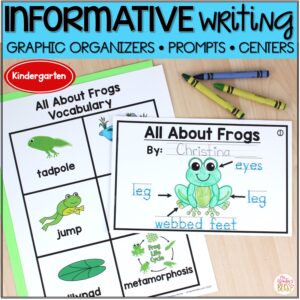
The kindergarten , first grade, and the second grade resources all include information to help you teach the unit, as well as mini-lesson to provide your students a review of informative writing. You’ll get a list of suggested mentor texts and online resources, academic vocabulary posters, a printable fact vs. opinion anchor chart, and graphic organizers appropriate for each grade level.
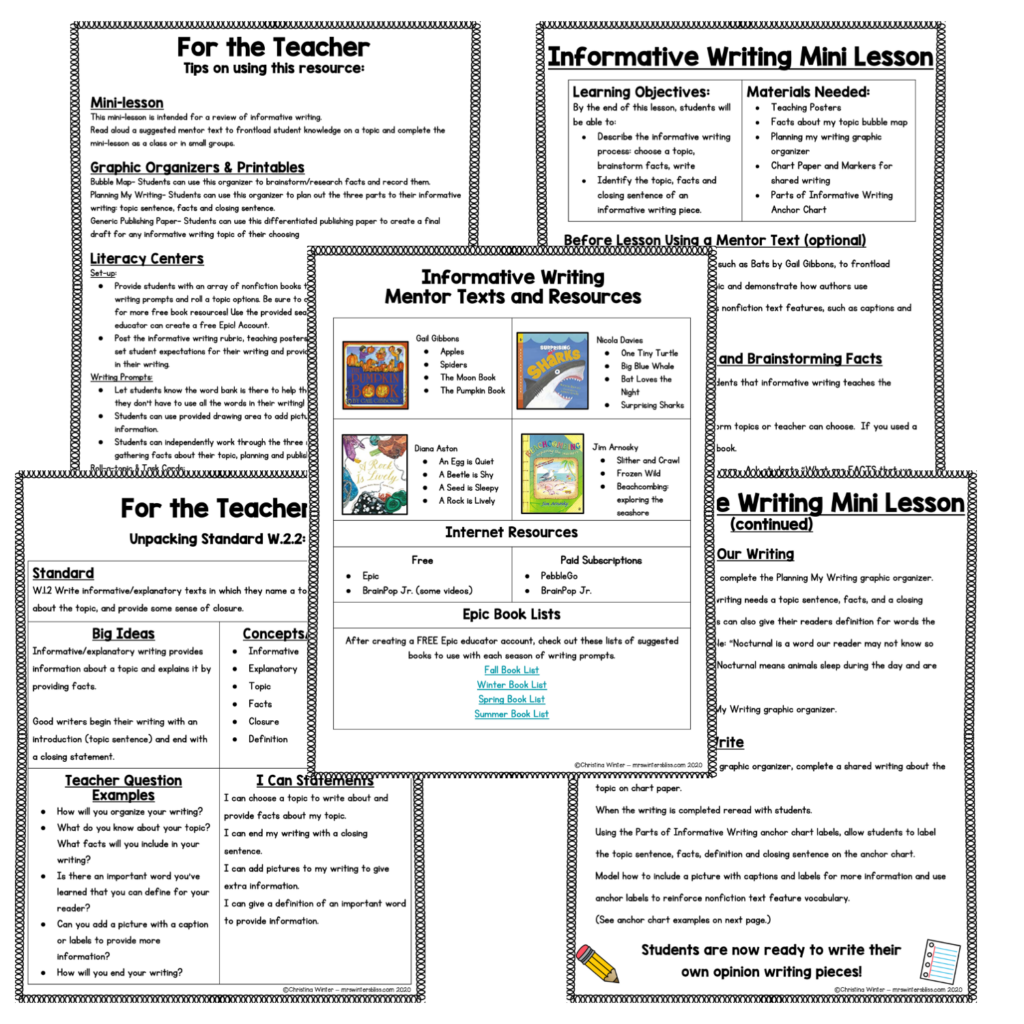
The kindergarten resource also includes the materials needed for students to create seasonal writing mini-books . Each mini-book comes with traceable sentence stems and a picture supported vocabulary word bank. This helps your young writers brainstorm ideas for what to write about and support their spelling.
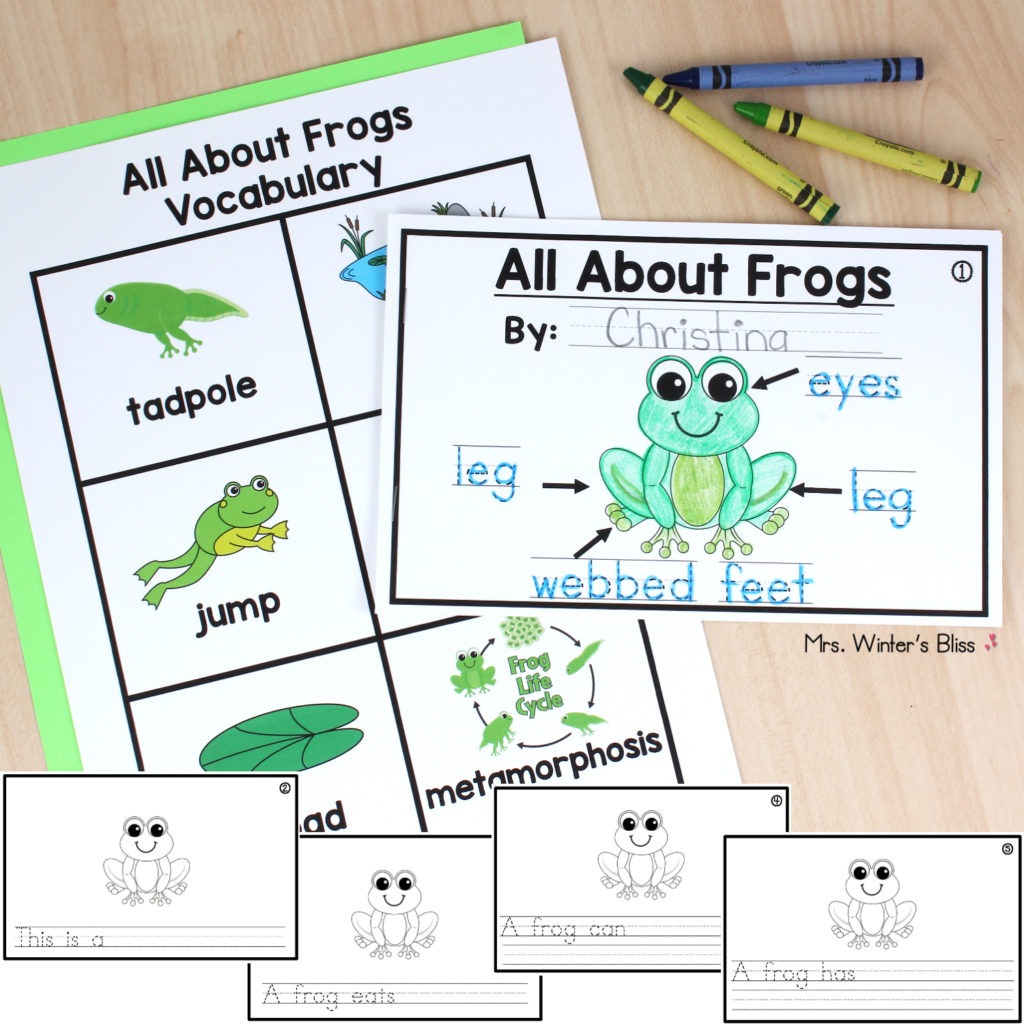
You’ll also get an editing checklist that is specific to informative writing but also appropriate for the kindergarten level.
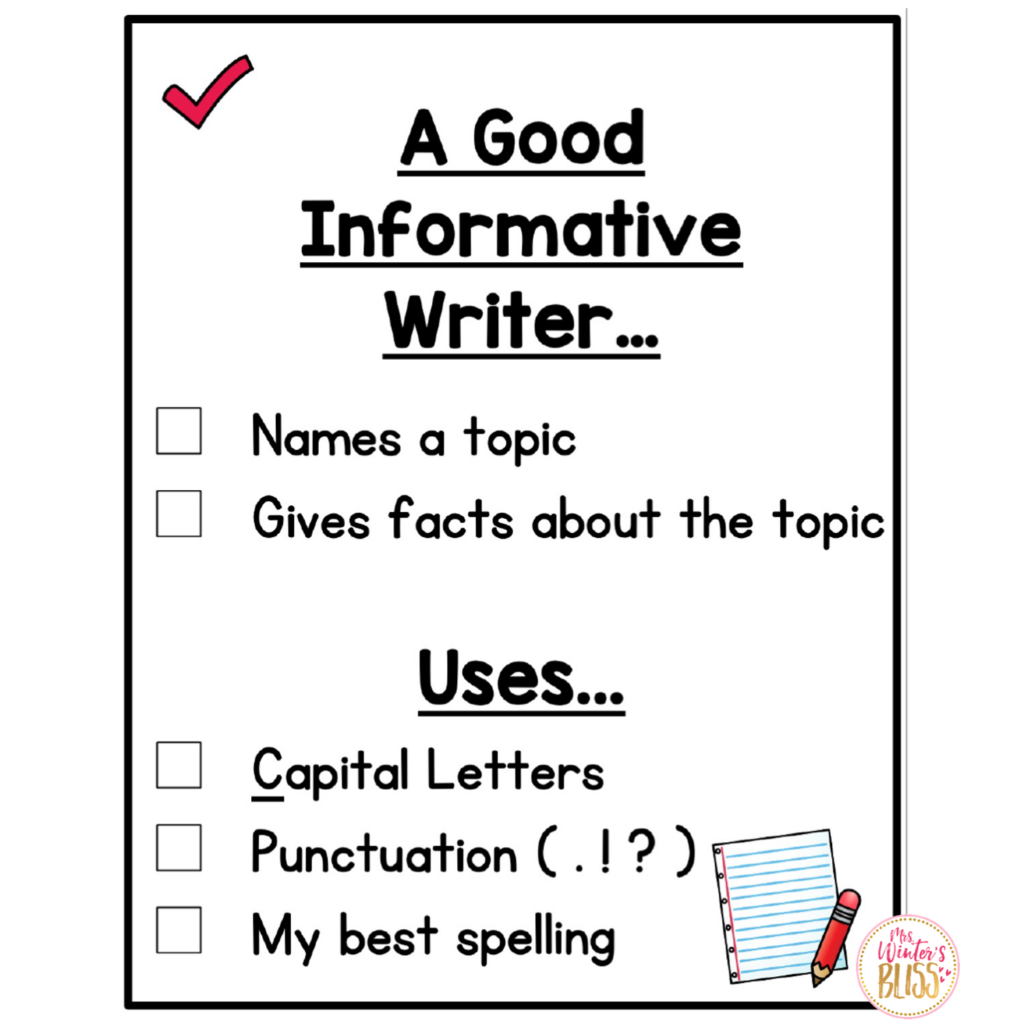
Instead of a seasonal mini-book, the first grade and second grade resource comes with seasonal writing prompts . You’ll get 5 informative writing prompts for each season, so you can practice informative writing all throughout the year.
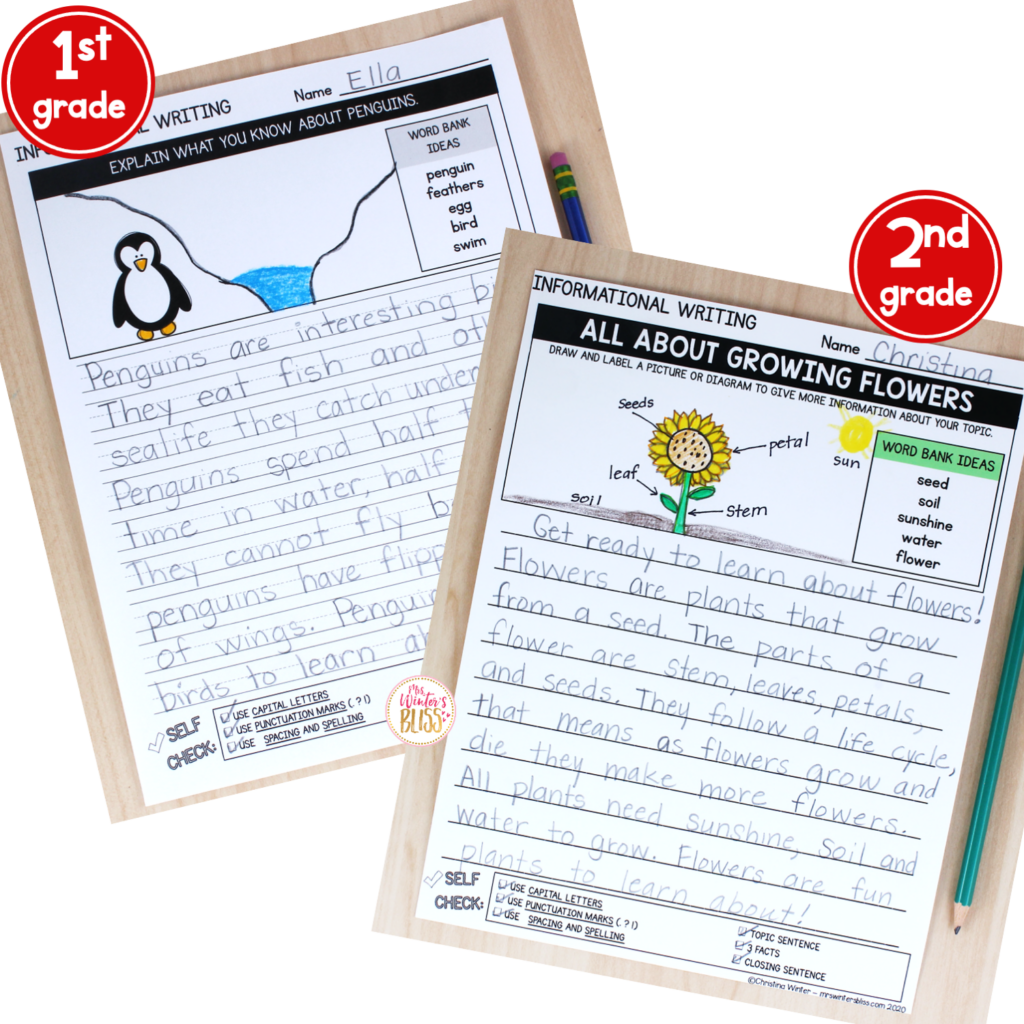
The prompts are both PRINTABLE & DIGITAL. The digital version has been PRELOADED for you, with 1 click add them to your Google Drive or upload them to SeeSaw.
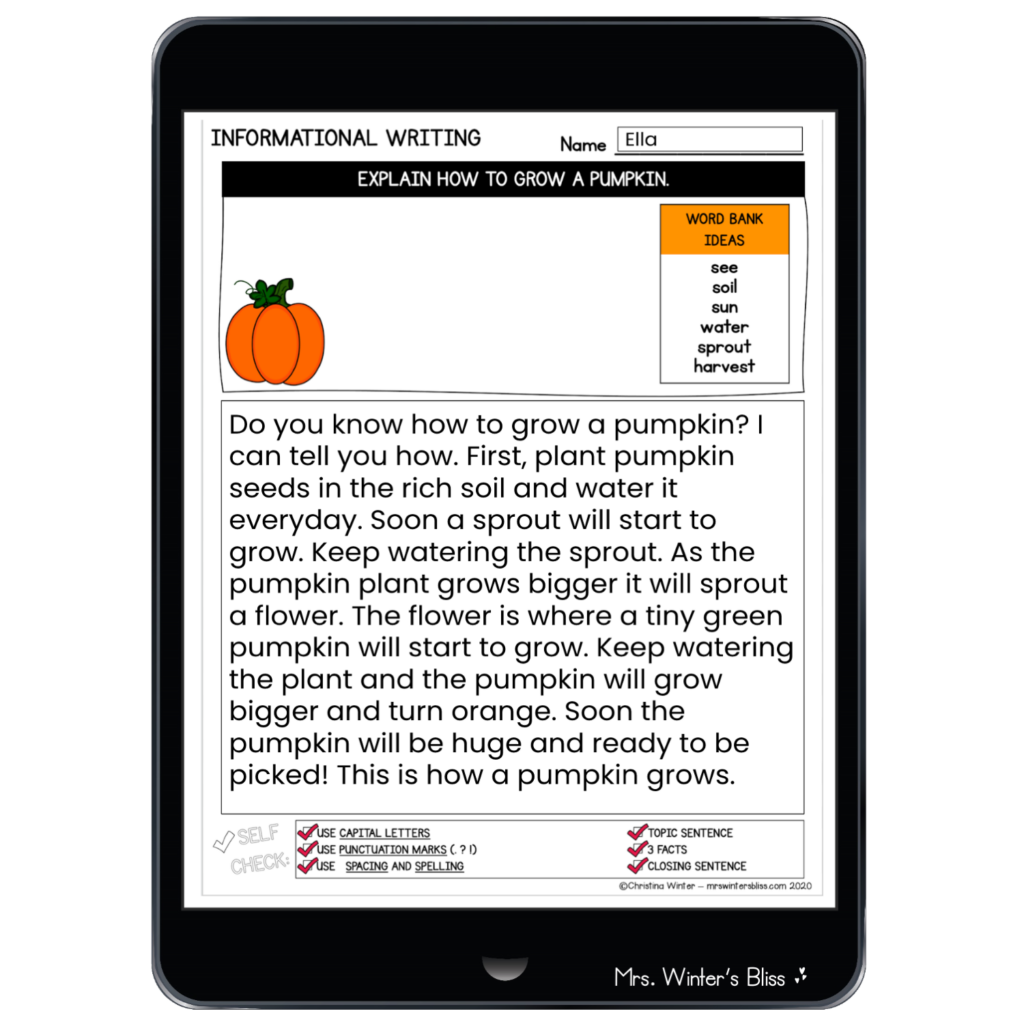
Each seasonal prompt also comes with publishing paper that includes a story specific vocabulary bank to provide spelling support and help students get ideas for what to write about.
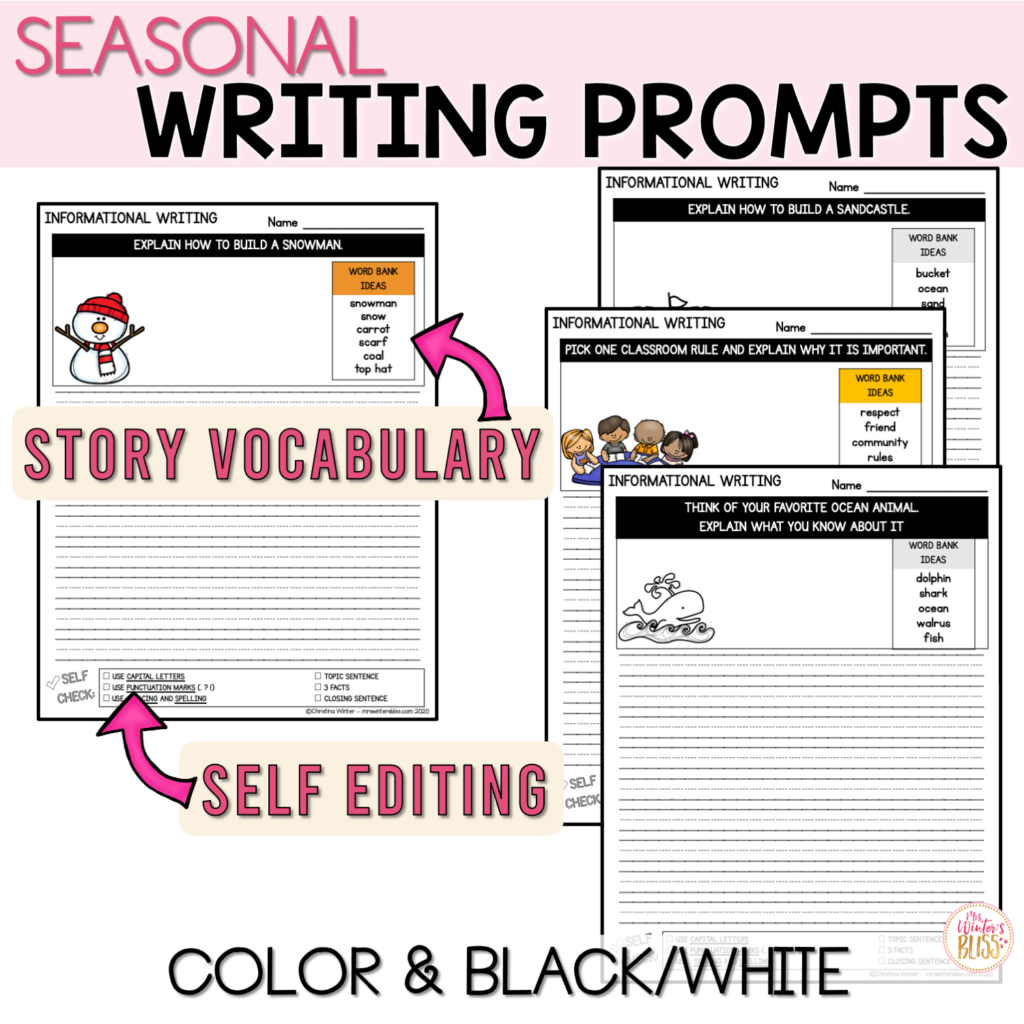
Finally, you’ll also get a self-editing checklist and rubric that have both been made specifically for informative writing. This rubric can be used to help guide students as they work on their pieces, and/or as a self-assessment tool.
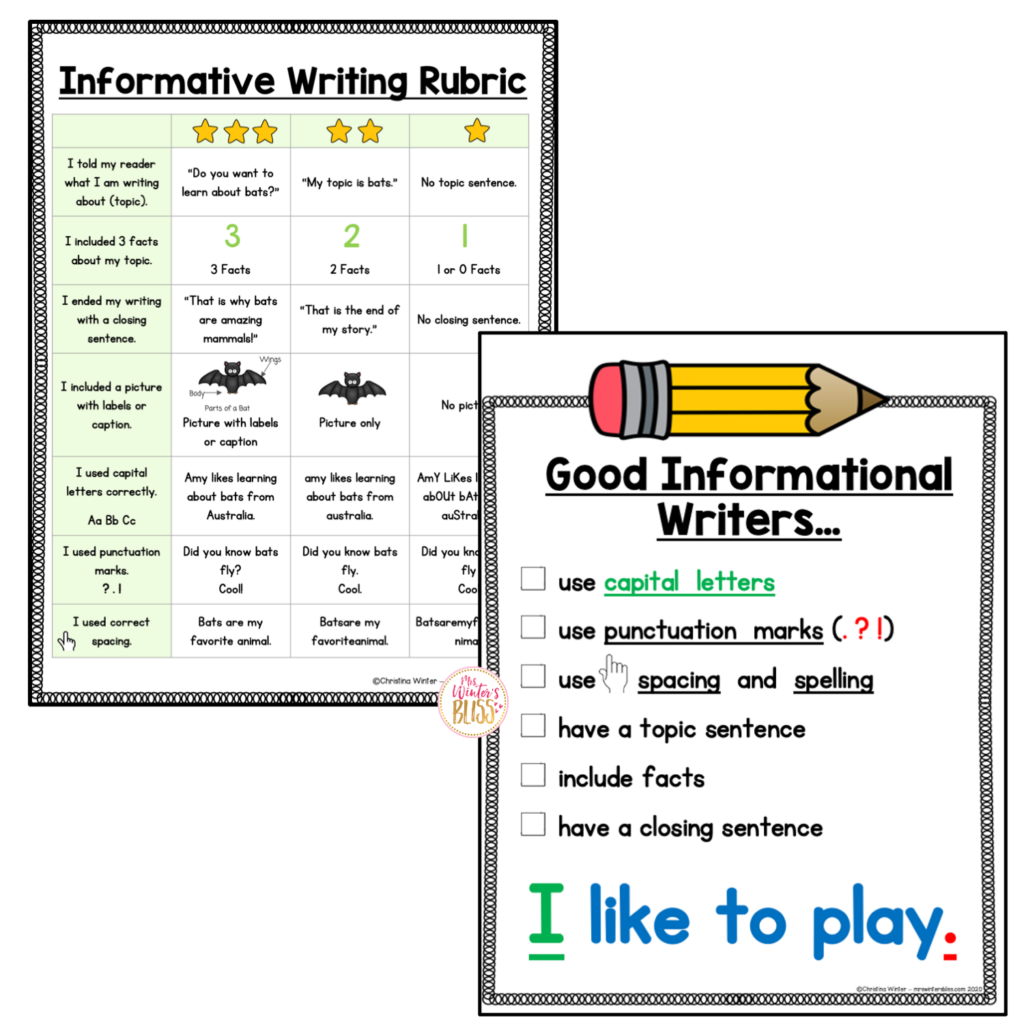
I love these resources because they can be used in so many different ways. They offer opportunities for students to practice informative writing as a whole class, in small groups, as a literacy center activity, for homework, or as a meaningful activity for when you have a substitute teacher! They provide k-2 students with all the practice they need to master informative writing!
FREE Informational Writing Graphic Organizers
Are you ready to begin teaching informative writing in your classroom? To help get your students started, I am happy to offer you 3 FREE informational writing graphic organizers! Download them here!
Helping your students to develop their ability to explain their ideas and share information with others is a valuable academic and life skill they will use well beyond the walls of your classroom. I hope the information and resources I’ve shared today will help to bring stronger informative writing instruction and more meaningful practice to your kindergarten, first and second grade classrooms!
Be on the lookout for my next post that will focus on another genre… Opinion Writing ! I’ll share information and tips for teaching opinion writing, as well as give you details about my Opinion Writing Units for Kindergarten , First and Second grade students!
-shop this post-
– PIN for LATER –

FIND WHAT YOU NEED
Teaching resources.

BLISS IN YOUR INBOX
COPYRIGHT © 2024 · TERMS AND CONDITIONS

IMAGES
VIDEO
COMMENTS
Look at a third-grade opinion rubric. Select a topic and write three short essays about it. Write one essay that clearly qualifies as an excellent essay; one that meets the requirements of a good essay, and one that is a poor essay. This will not take long because third-grade essays are usually not very long. 2.
How to Teach Writing to Third Graders: Bonus Tips. Add a free write day each week. This keeps students who love to write extra engaged in the process. Play a game like Left, Right, Center when it comes to editing and revising. You roll a dice and if it says to pass the paper to the left or right, the students do so.
Third graders can write an essay with a simple thesis statement, examples and supporting details, and a thoughtful concluding sentence. They are building skills in the writing process — research, planning, organizing, revising , and editing (with help from teachers and peers).
According to the California Department of Education, third-grade students should be able to write well-developed essays that clearly illustrate a main idea. Students this age should be familiar with both narration and description and use standard English conventions. Third-graders need to apply the writing process to ...
Magnify an MVP. Worksheet. 1 2. Essays become standard as elementary school progresses. Third grade essay writing worksheets help kids overcome writer's block and encourage teamwork and skill-building instead. Your child will create opinion-based pieces, elaborate on internal feelings, and learn to organize their thoughts as they write.
Writing The Body of an Opinion Essay. We can teach our 3 rd, 4 th, and 5 th graders to adhere to structure when they write the body paragraphs of their opinion essay too.. Each body paragraph needs to have a reason introduced by a topic sentence, supporting details that support the reason, and a concluding sentence that sums up that body paragraph.If students are explicitly taught this ...
Terrific Writing is a comprehensive writing curriculum for Third Grade. This curriculum is standards based (to the common core) and genre based. But best of all, it's actually easy to teach and engaging for students! In this curriculum, your students will develop a love of writing.
Keep reading to see our best tips for teaching opinion writing. 1. Start with a pre-assessment. The first must-do tip for teaching opinion writing is to start with a pre-assessment. The pre-assessment allows you to see how much students know so you can tailor your lessons appropriately and it allows you to measure student growth at the end of ...
Students should be encouraged to learn words they frequently misspell, as well as words they wish to include in their writing. Teachers also should help students acquire the skills they need to generate and check plausible spellings for words. 3. Teach students to construct sentences for fluency , meaning and style.
An argumentative text is a piece of writing in which the author states a claim, or position, and supports it with evidence to make the reader understand it as a valid argument. The author relies on logic, facts, and credible sources to make his/her argument. This means that a lot of the real work begins before the author puts pen to paper with ...
Kids in third grade are expected to write informational essays. That involves steps like coming up with ideas and supporting them. Watch this video from Understood founding partner GreatSchools to find out how most kids this age go about writing an essay. Find out how third graders typically go about writing informational essays, from forming ...
Third graders should use increasingly precise words. This means understanding root words (e.g. knowing that add is the root of addition and additional ), choosing the right word from synonyms (e.g. knew, believed, suspected, heard, wondered ), and using words to signal timing (e.g. after, then, later ). With all this focus on word nuance, your ...
Students begin by writing their opinion statement (O), then give a reason (R), an example (E), and restate their opinion (O). This is a very basic structure that you can use for introducing opinion writing. From there, you'll want to teach your students how to write an opinion essay! Check out my Opinion Piece Writing Units (Grades 2-5)!
Video: How third graders do research for an essay. Kids in third grade are learning to write essays. The first steps are figuring out how to "research" a topic and organize information. Watch this video from Understood founding partner GreatSchools to learn what strategies kids this age typically use for researching and organizing their ideas.
From dialogue writing worksheets to Olympic writing activities, we've got you covered on resources for all of your instructional needs. Kids can write a letter to someone in history or be an adjective detective and learn essential writing skills at the same time. Get additional third grade reading help with our library of resources.
Written by a third grader who receives special education for language arts. Writing is in response to a prompt, "Think about a person who is special; this could be a family member, a friend, or anyone else who is important to you. Write about why this person is special to you. Be sure to describe a few experiences you have had together that ...
Choose a Topic. You write an expository essay to tell or teach the reader about a topic. Start by choosing a topic that you think is interesting and that you already know a lot about. You might choose to write about an animal you like, a place you have visited or a person whom you have read about. If you have too many ideas, make a list and ...
To be sure, kids can be good writers before third grade, but grade 3 is such a great time to hone in on specific writing skills. Take a look at some of my favorite lessons and activities that help to build foundational writing skills in third grade. Text: The Best Writing Lessons for Third Grade. Image: School supplies are displayed on a blank ...
The number of paragraphs contained in an essay will depend on a number of factors such as word limits, time limits, the complexity of the question etc. Regardless of the essay's length, students should ensure their essay follows the Rule of Three in that every essay they write contains an introduction, body paragraphs, and a conclusion.
FreebiesContactShop. Persuasive Writing in Third Grade. The art of persuasion. It seems that many kids do their very best to persuade their parents, friends and, yes, even teachers to see their point of view. Kids are excellent at trying to persuade others to do their bidding. Even my toddler seems to be honing her skills, always trying to find ...
Outline. The last thing to do before starting to write an essay is to make its outline. Choose some topic and make a list of points your students would need to mention if they wrote an essay on it. Such a technique will give them a better understanding of what and essay is, and how it should be written. Make sure that all students perfectly ...
If the phrase was "8th birthday", because the essay is going to be a personal narrative about the best birthday party you've ever had, turn the phrase into the sentence "My 8th birthday party was the best party I've ever had." Technically, in some 2nd-3rd grade writing standards, you could have the kids stop here.
You can also show how you add more details to make your piece more informative for your reader. 3. Use Anchor Charts. You want your students to know that when they write an informative piece they are sharing facts, or true information, with their reader. They are not sharing their opinion.